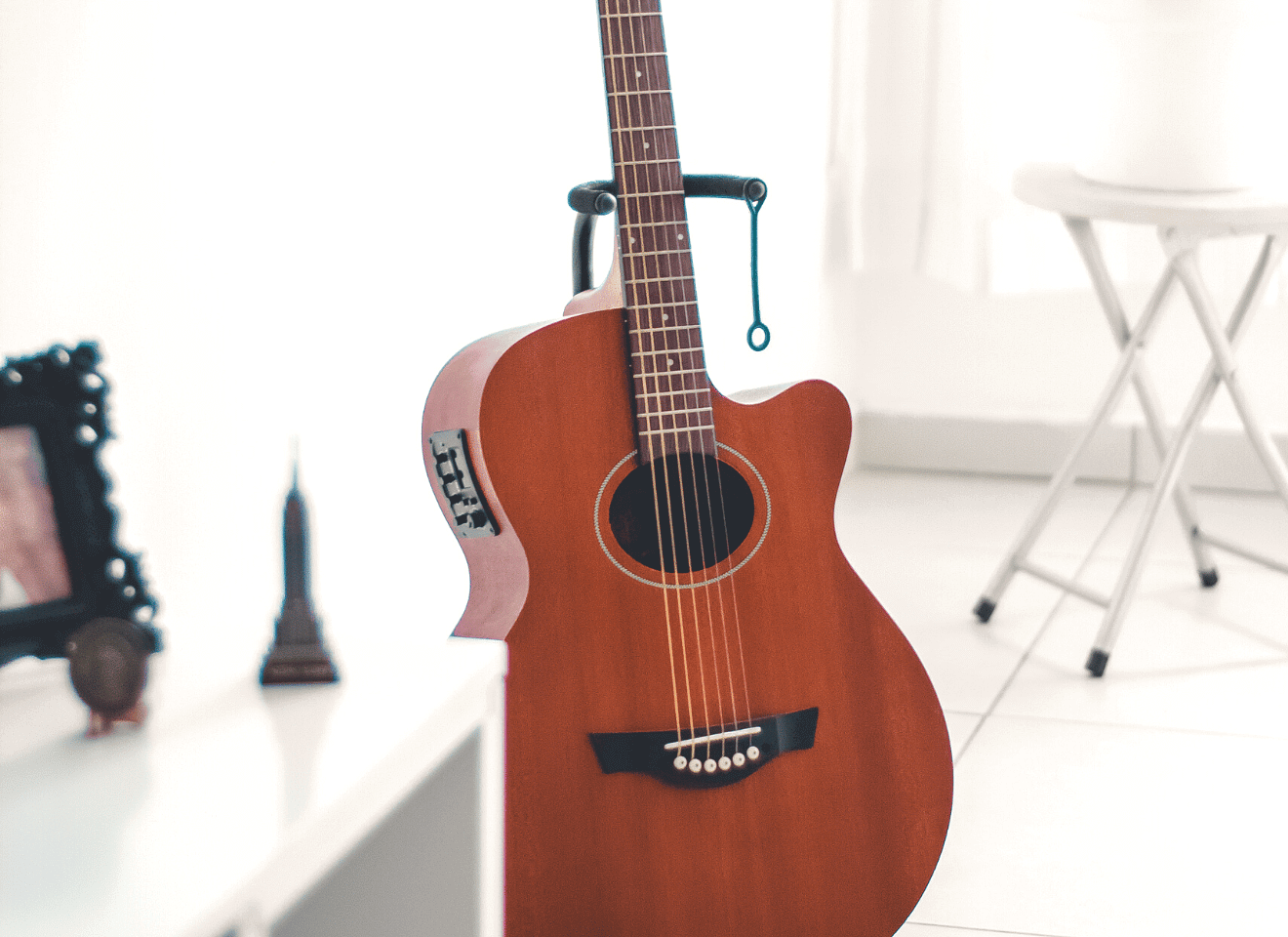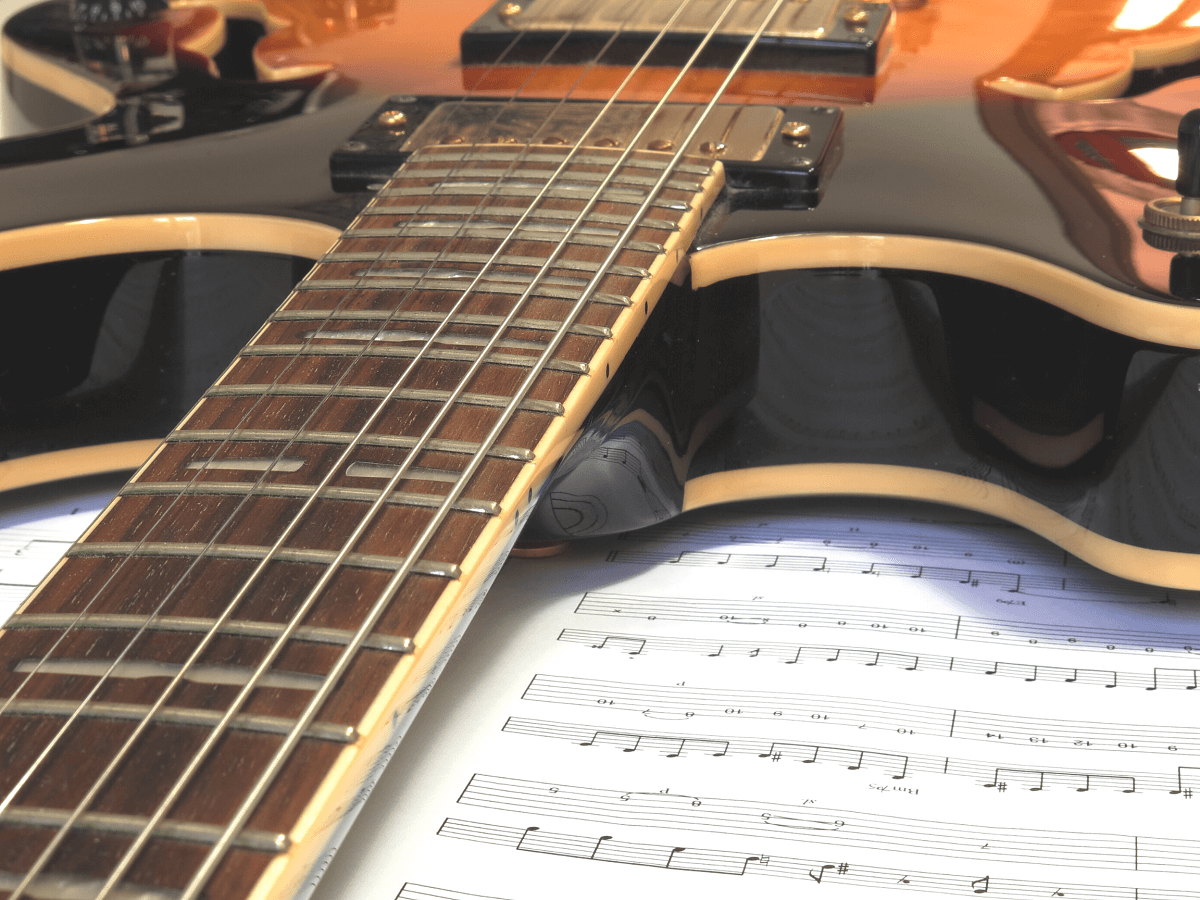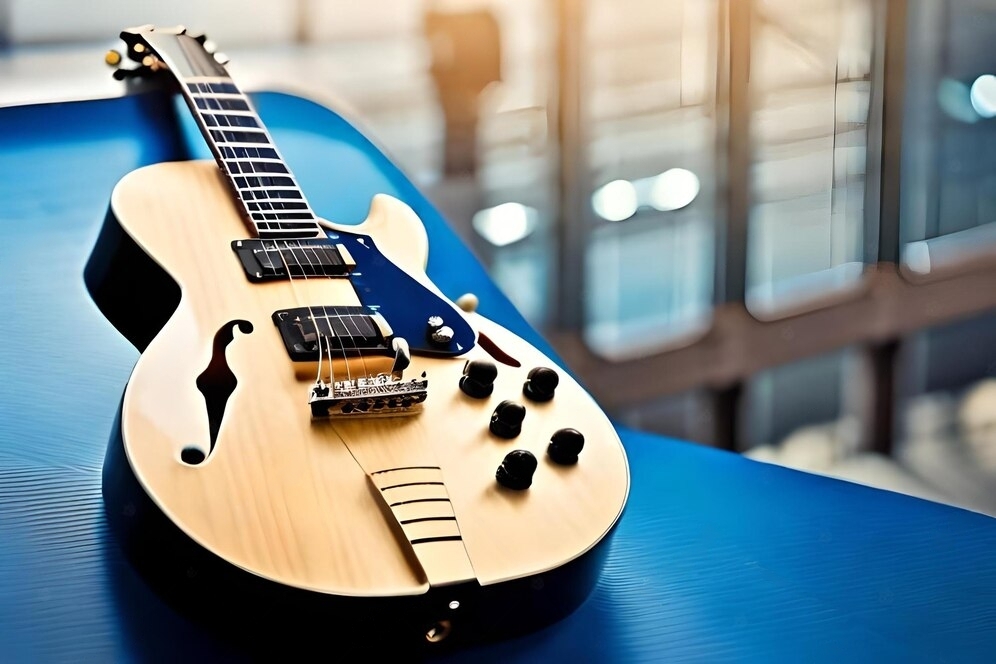Whether you are a seasoned pro or an emerging artist, there are countless acoustic-electric guitars that could cater to your specific needs.
The market today is saturated with instruments from different manufacturers, boasting varied features, aesthetics and price ranges.
Thus, choosing the perfect acoustic-electric guitar can pose quite the challenge for most music enthusiasts and professionals alike.
Moreover, the quest becomes even more difficult when looking for the greatest ones ever crafted.
This article simplifies your search by handpicking the best 25 acoustic-electric guitars of all time, which have been widely acclaimed by guitarists worldwide.
The following list takes into account factors such as sound quality, playability, build, functionality and overall value, making it a comprehensive guide for those seeking only the very best.
Table of Contents
- Best Acoustic-electric Guitars Of All Time
- Taylor 214ce Deluxe Grand Auditorium Acoustic-Electric Guitar
- Yamaha FGX820C Solid Top Cutaway Acoustic-Electric Guitar
- Fender CD-60SCE Solid Top Dreadnought Acoustic-Electric Guitar
- Ibanez AW54OPN Acoustic-Electric Guitar
- Epiphone Hummingbird PRO Acoustic-Electric Guitar
- Takamine GN93CE Acoustic-Electric Guitar
- Kadence Acoustica Series Acoustic Electric Guitar
- Martin DJR-10E Streetmaster Acoustic Guitar
- Fender American Acoustasonic Jazzmaster Acoustic-Electric Guitar
- Taylor Academy 12e-N Acoustic-Electric Guitar
- Guild F-2512E Acoustic-Electric Guitar
- Yamaha A5R ARE Acoustic-Electric Guitar
- PRS Limited Edition SE P20E Parlor Acoustic-Electric Guitar
- Fender American Acoustasonic Telecaster Acoustic Electric Guitar
- Yamaha Storia III Acoustic Guitar
- Martin SC-13E Acoustic-Electric Guitar
- Taylor AD17e Blacktop Acoustic-Electric Guitar
- What to Look for When Buying Acoustic-Electric Guitars?
- How Do You Maintain an Acoustic-Electric Guitar?
- What are the Typical Materials Used in These Guitars?
- Nylon Strings vs. Steel Strings, Which One to Choose?
- How to Tell if a Guitar Has Good Sound Quality?
- What are the Best Brands in the Acoustic-Electric Guitar Industry?
- Acoustic Guitars vs. Acoustic-Electric Guitars?
- What are the Different Types of Acoustic-Electric Guitars?
- How Important is the Size of an Acoustic-Electric Guitar?
- What Role does the Shape Play in an Acoustic-Electric Guitar’s Sound?
- The Bottom Line
Best Acoustic-electric Guitars Of All Time
Before I begin, here are my top selected choices:
|
|
Fender CD-60SCE Solid Top Dreadnought Acoustic-Electric Guitar

Solid top guitar with easy upper-fret access. Check Price
|
Kadence Acoustica Series Acoustic Electric Guitar

High-quality, easy-to-use acoustic-electric guitar for all levels.
Check Price
|
Taylor 214ce Deluxe Grand Auditorium Acoustic-Electric Guitar
Versatile, high-quality guitar with exceptional sound clarity.
This guitar is a grand auditorium-shaped instrument with six strings made from alloy steel and a layered rosewood back. The body features a Venetian cutaway and Sitka spruce top, while the neck is constructed from Sapele wood with a Rosewood fretboard. It also has professional-grade electronics and is designed for right-hand orientation.
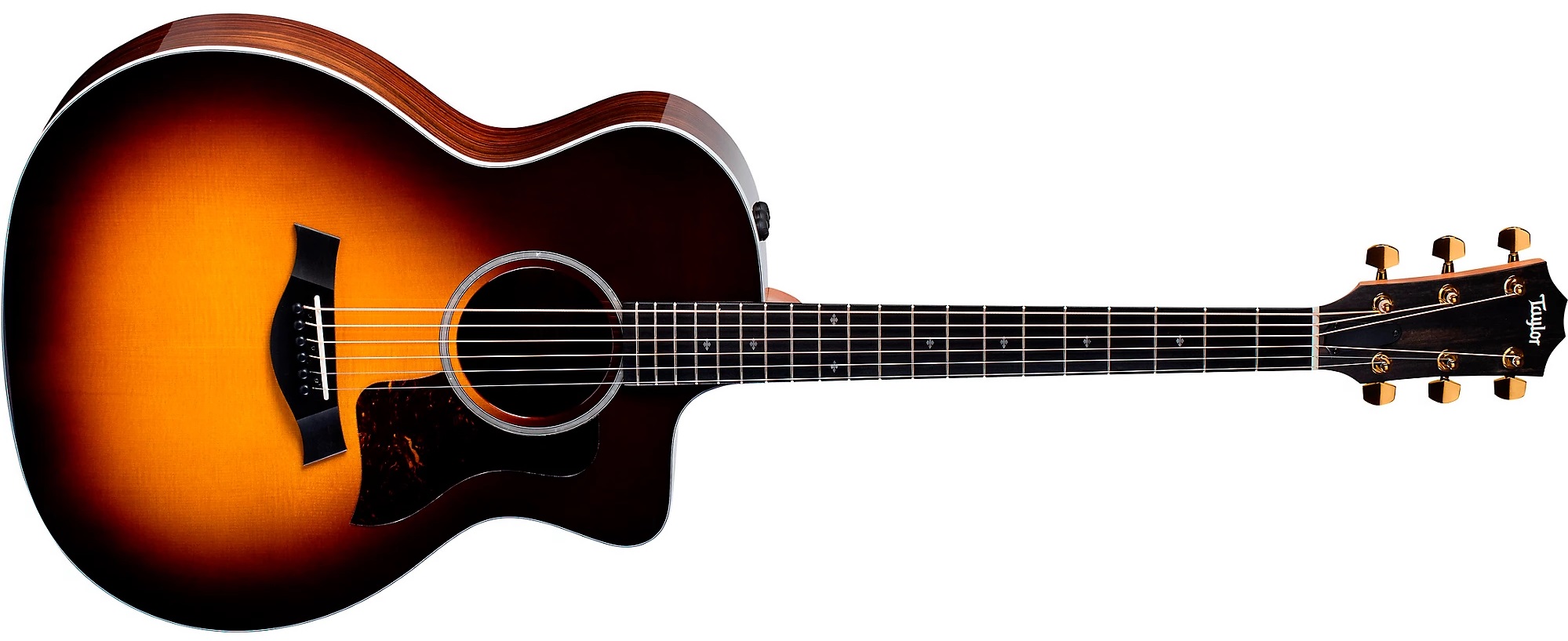
The Taylor 214ce Deluxe Grand Auditorium Cutaway Acoustic-Electric Guitar is a natural-coloured beauty that truly stands out with its unique features.
Designed with a Grand Auditorium shape, it hosts the standard six strings and sports a 25-1/2″ scale length, ideal for a variety of music styles.
Its back and sides are composed of layered rosewood, adding visual appeal and tonal quality, while the top boasts Sitka Spruce, renowned for stiffness and elasticity that result in a broad dynamic range of sounds.
With a body length and width of 20″ and 16″ respectively, the body depth measures in generous at 4-5/8″, a genuine attention grabber is the Venetian-style cutaway.
Ensuring excellent tone, the NuBone Nut/Tusq Saddle offers perfect pitch, the neck and heel crafted from robust sapele wood, and a fretboard of superior ebony wood sporting small diamond inlays.
Provision of Expression System electronics paves the way for amplified play, with an Indian Rosewood headstock overlay adding a touch of elegance.
Moreover, it’s a Taylor branded guitar, built robustly with a spruce wood top, rosewood body, and a sapele wood neck, complete with a rosewood fretboard and alloy steel strings.
The guitar is designed for right-handed players and offers a fulfilling and versatile playing experience, enriched with tonal clarity.
- My Review
As a seasoned guitar player, I can affirm that the Taylor 214ce Deluxe Grand Auditorium Cutaway Acoustic-Electric Guitar is a solid musical instrument that offers notable versatility and impeccable sound quality.
Undoubtedly crafted with keen attention to detail, its top material is made from Sitka spruce wood, a combination that ensures stiffness and elasticity in perfect balance, translating into a dynamic range of sounds with crisp articulation.
It is worthy to talk about the rosewood used for the Body and Back material, which adds an extra layer of solidness and provides a strong platform for the vibrating string energy sent by the guitar’s top.
However, while it is a thing of wonder acoustically, feedback whilst amplified can occasionally unsettle, becoming a potential pitfall for musicians who frequently perform on stage or participate in recordings.
Boasting an Expression System for the electronics, the guitar welcomes modernity along with tradition, but the feedback from amplification slightly belittles its highly appraised electronic system.
Nevertheless, for unamplified play, the Taylor succeeded in stealing my heart with its vibrant and full-bodied sounds that are a testament to an excellent guitar design.
Adding to this, the venetian cutaway design yields an aesthetic appeal in its own league, gracefully mirroring the guitar’s audial charms.
I was taken by the feature of the Nubone Nut/Tusq Saddle as well, which not only provides greater stability but also enhances the tone of the guitar.
The rosewood fretboard along the sapele wood neck adds a luxurious touch to the overall visual appeal while also enhancing the playability of the instrument.
Encompassing six strings, this guitar creates a indelible impression for live performances as well as for personal and leisurely jamming sessions.
The built-in Neubone Nut and Tusq Saddle further exemplifies the attention to detail at every level with this guitar, lending to sustain and resonance that’s noticeably superior to conventional materials.
However, once again, the amplified sound falls significantly short of its acoustic counterpart, which is something one needs to keep in mind when considering this guitar for amplified performances or recordings.
The Taylor 214ce Deluxe Grand Auditorium Cutaway Acoustic-Electric Guitar is a stellar instrument with many outstanding features, but it might not be the right fit for those who spend much of their time playing amp-bound.
- Pros:
- Great sound quality and volume.
- Beautiful design and durable construction.
- Comfortable and easy to play.
- Cons:
- Amplified sound lacks quality.
- May experience feedback issues.
- Some users found it overpriced.
My final verdict is that the Taylor 214ce Deluxe Grand Auditorium Cutaway Acoustic-Electric Guitar is a top-notch choice for any musician.
With its strong, crisp articulation provided by the Sitka spruce wood top and layered rosewood back and sides, it ensures great tonal quality.
The guitar’s versatility and playability is remarkable, due to its Grand Auditorium body shape and striking balance between design and functionality.
The highly professional-grade Taylor ES2 pickup is a revolutionary addition that pickers, strummers and flat-pickers alike will appreciate.
In terms of value for money, durable materials, and premium features – this product stands out among its peers.
Yamaha FGX820C Solid Top Cutaway Acoustic-Electric Guitar
Strong, warm sound with optimal sound tailoring.
This acoustic-electric guitar features a solid Sitka spruce top and mahogany back and sides, offering a stronger, warmer sound. Its Rosewood fingerboard and adjustable truss rod, paired with a 3-band EQ and precision chromatic tuner ensure optimum sound tailoring. With cream plastic binds for an enhanced look and a wealth of color options, it blends functionality and aesthetics effortlessly.
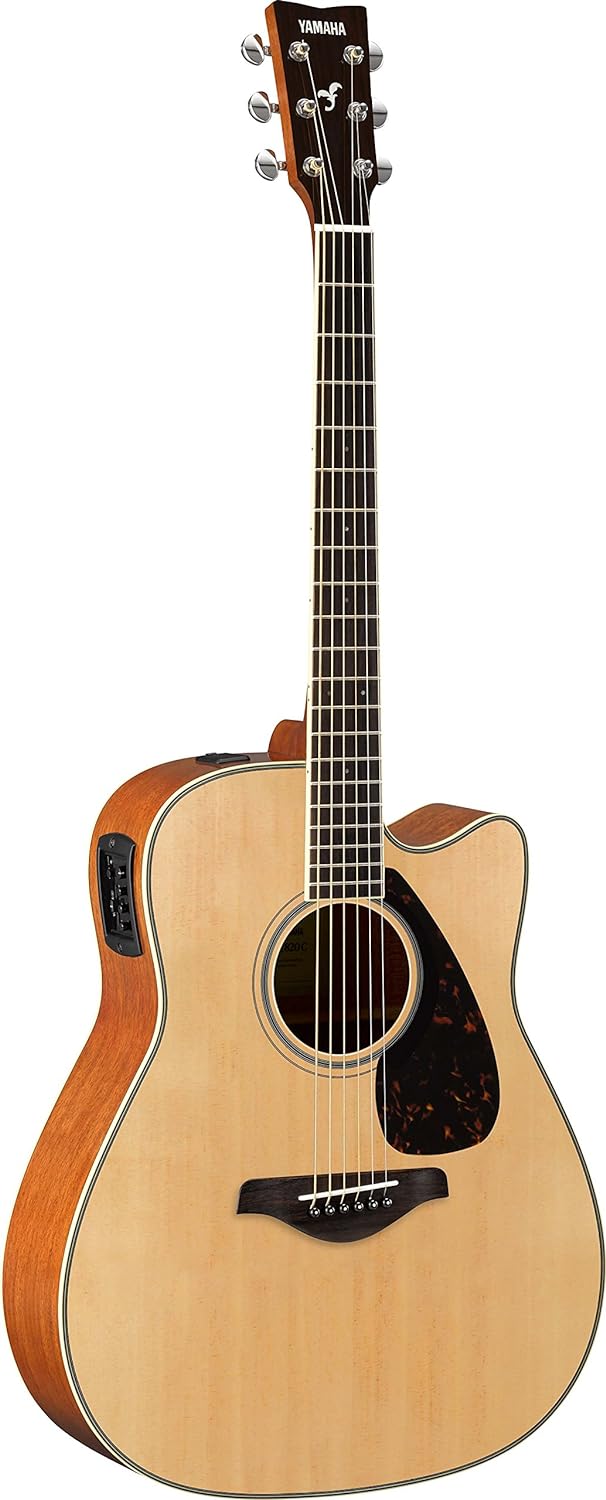
Featuring a solid Sitka Spruce top, the Yamaha FGX820C Cutaway Acoustic-Electric Guitar, presented in a natural finish, clearly exhibits its quality materials.
Complemented by Mahogany on the back and sides, this guitar ensures a strong and warm sound.
Its fingerboard, as well as the bridge, is made from Rosewood, adding another layer of tonal depth.
A notable feature is the use of Diecast tuners, an assurance of tuning stability.
What differentiates this guitar is its System 66, which includes an under-saddle piezo pickup equipped with a 3-band EQ, an adjustable mid-range frequency controller, and an incredibly precise chromatic tuner.
This allows for optimum sound sculpting, ensuring your road to finding the perfect tone is smoother.
Another important feature is the guitar’s adjustable truss rod, which provides flexibility in modifying the guitar’s neck relief to suit different playing styles.
The Yamaha FGX820C is also aesthetically pleasing, with its body and fingerboard binding made of cream plastic, resulting in an upgraded and sleek look.
Alongside the quality sound and playability, Yamaha offers a range of color options to choose from, catering to individual aesthetic preferences.
- My Review
Upon landing my fingers on the Yamaha FGX820C Solid Top Cutaway Acoustic-Electric Guitar, I was taken aback by the remarkable sound it produces.
The Solid Sitka Spruce Top, coupled with the rich Mahogany back and sides, results in undeniably warm and strong tones.
What struck me as remarkable, is the guitar’s rosewood fingerboard and bridge, which contribute to the overall comfortable playing experience.
Bearing in mind the convenience the guitar offers due to the system 66, which boasts an under-saddle piezo pickup with a 3-band EQ, an adjustable mid-range frequency control, and a precision chromatic tuner, this guitar offers a tailored sound to suit your unique playing style.
This feature contributes to the exceptional versatility of this guitar, making it not just a musical instrument but a tool for expressing personal preference in sound.
Additionally, the adjustable truss rod is a noteworthy attribute for players who appreciate the ability to fine-tune the guitar’s neck in accordance with their preference.
One of the first factors that my eyes settled on was the attention to detail in the cream plastic body and fingerboard binding, a charming upgrade from earlier models which enhances the visual appeal of this instrument.
From the first strum, I immediately noticed the sound being incredibly bright, with an impressive projection and sustain, it was quite unexpected for a guitar at this price range.
The combination of these factors crafted a well-balanced sound throughout the entire frequency range.
In terms of aesthetics, the Mahogany back and sides are not just for sound, as they also add an alluring charm to the guitar’s overall appearance.
Despite being a majority mahogany guitar, I must say I was surprised with the weight – or lack thereof – it is certainly not a heavy-duty piece of wood, making it easier to handle and adding comfort to every jam session.
On the other hand, I did identify a few areas for possible improvement. For instance, the positioning of the pick guard seems slightly off and could be distracting for some players.
Apart from that, certain aspects of craftsmanship were not consistent across the board; there were noticeable flaws such as an overly high action and sloppily cut holes for the bridge pins.
Last but not least, despite the slight blemishes and workaround required for setup, I would say that the Yamaha FGX820C stands as an impressive offering for intermediate players or those looking for an upgrade from basic models.
- Pros:
- High-quality sound and volume
- Well crafted and durable
- High value for money
- Cons:
- Delivery issues mentioned by users
- Minor quality control issues
- High action reported by some
My final verdict is that the Yamaha FGX820C Solid Top Cutaway Acoustic-Electric Guitar is a top-tier instrument for both professionals and beginners.
Its Solid Sitka Spruce Top and Mahogany Back and Sides provide a warm and strong sound needed for any performance.
The guitar’s System 66 feature allows you to tailor the sound to your preferences, making it highly versatile for various music styles.
With an adjustable truss rod and an impressive choice of color options, this guitar doesn’t only sound good, but looks good too.
I would highly recommend this Yamaha Guitar for anyone looking for high-quality sound and an aesthetically pleasing musical instrument.
Fender CD-60SCE Solid Top Dreadnought Acoustic-Electric Guitar
Solid top guitar with easy upper-fret access.
This guitar boasts a Venetian-cutaway body for upper-fret access and a solid spruce top with scalloped X-bracing. Its durable construction includes mahogany back, sides, neck and a rosewood fretboard. Enhanced features like the Fishman Classic Design pickup/preamp and Fender Dura-Tone coated strings make it truly versatile.
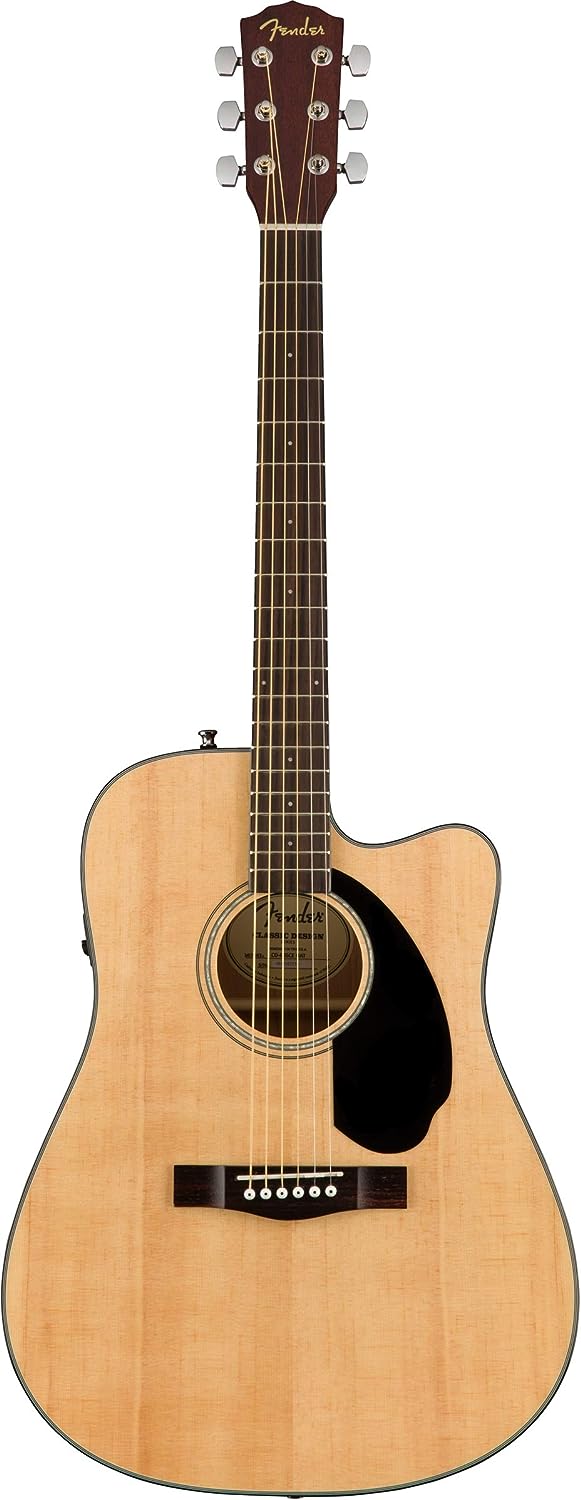
The product under discussion is the Fender CD-60SCE Solid Top Dreadnought Acoustic-Electric Guitar, it is presented in a natural color that accentuates its aesthetics.
It boasts a solid spruce top coupled with mahogany back and sides, designed with a unique scalloped “X” bracing for enhanced sound quality.
A significant highlight includes the Venetian-cutaway body design which offers ease of access to the upper frets, making it ideal for the more advanced players and techniques.
Playing this guitar is made even more comfortable with its smooth neck and rolled fingerboard edges, adding an extra level of convenience for the player.
Another excellent feature of this guitar is its Fishman Classic Design pickup/preamp, providing a high-quality sound output, adding richness and depth to the output.
Interestingly, the strings are made of Fender Dura-tone, easing the playing process and providing a distinct sound that sets it apart.
This bundle comes with a hard carry case, a cable, a tuner, a strap, extra strings, picks, and even an Austin Bazaar Instructional DVD for those keen on learning.
Furthermore, maintaining this guitar to ensure its longevity is a cakewalk, all thanks to the included polishing cloth that ensures your guitar always looks as good as new.
To add to all this, it should be highlighted that this product is a creation of the renowned brand, Fender, known for their high-quality and durable musical instruments.
- My Review
First and foremost, the Fender CD-60SCE Solid Top Dreadnought Acoustic-Electric Guitar carries a distinguished aesthetic appeal with its natural color and design.
Constructed with the top material from solid spruce, the design also features scalloped “X”-bracing that aids in excellent sound projection and resonance.
What caught my attention was the Venetian-cutaway body, that offers upper-fret access, proving beneficial for complex solos or intricate fingerpicking styles.
The mahogany back and sides accompany the spruce top to enhance the guitar’s tonal quality, blending the richness of mahogany with the brightness of spruce seamlessly.
Deeply invested in the experience I felt while strumming the strings, I realized that the easy-to-play neck, comprised of solid mahogany and embellished with rolled fingerboard edges, promotes swift chord transitions and effortless fingering.
I found the strength of sound quite impressive, attributable to the Fishman Classic Design pickup/preamp, that delivers a clear and crisp sound, across both acoustic and plugged-in sessions.
The guitar also incorporates Fender® Dura-Tone® 880L Coated 80/20 strings that maintain their tone even after extensive playing sessions.
With the right-hand orientation, it fits comfortably into my playing style.
Despite its virtues, however, I observed a few inconsistencies in the design of the Fender CD-60SCE.
I experienced a subtle issue with fret buzz around the 13th fret, which couldn’t be resolved even with truss rod adjustments or raising the action, perhaps due to a slight fret height inconsistency.
I also noticed that although lightweight, the guitar lacked substantial structural solidity, which posed concerns about its longevity.
Another point to be noted is that the action came a bit high from the factory, requiring a setup for optimal playability.
I happened upon an adhesive residue circling the sound hole upon removing the protective film, which needed careful cleaning with orange oil and a hairdryer to keep the surface intact.
Fender CD-60SCE is a considerable bundle for aspiring guitarists, offering a host of benefits from sound quality to a solid case and more, but does have a few quirks that require resolution.
- Pros:
- Excellent sound and intonation.
- Easy to play with rolled fingerboard edges.
- Value bundle with hard case, tuner, and more.
- Cons:
- Possible fret buzz at 13th fret.
- Guitar might need setup for best sound.
- Structurally weak, prone to cracking.
My final verdict is that the Fender CD-60SCE Solid Top Dreadnought Acoustic-Electric Guitar is a robust, multifaceted instrument that’s worth every penny.
With its solid spruce top with scalloped “X”-bracing, it provides an unparalleled sound quality.
The addition of the Fishman Classic Design pickup/preamp adds to the remarkable versatility of the product, making it suitable for both practice sessions and performances.
Lastly, the bundle of accessories that come with it, including the hard case, tuner, and more, add incredible value to the overall package.
Ibanez AW54OPN Acoustic-Electric Guitar
Traditional design meets modern tone in Ibanez AW54OPN.
This acoustic guitar hails from the Artwood Series by Ibanez, crafted with a blend of traditional methods and modern technology. Composed of a solid mahogany top, back, sides, and neck with a rosewood bridge and fretboard ensures brilliant sound quality. It features a unique open pore natural finish, a tortoise shell pickguard, and chrome die-cast tuners.
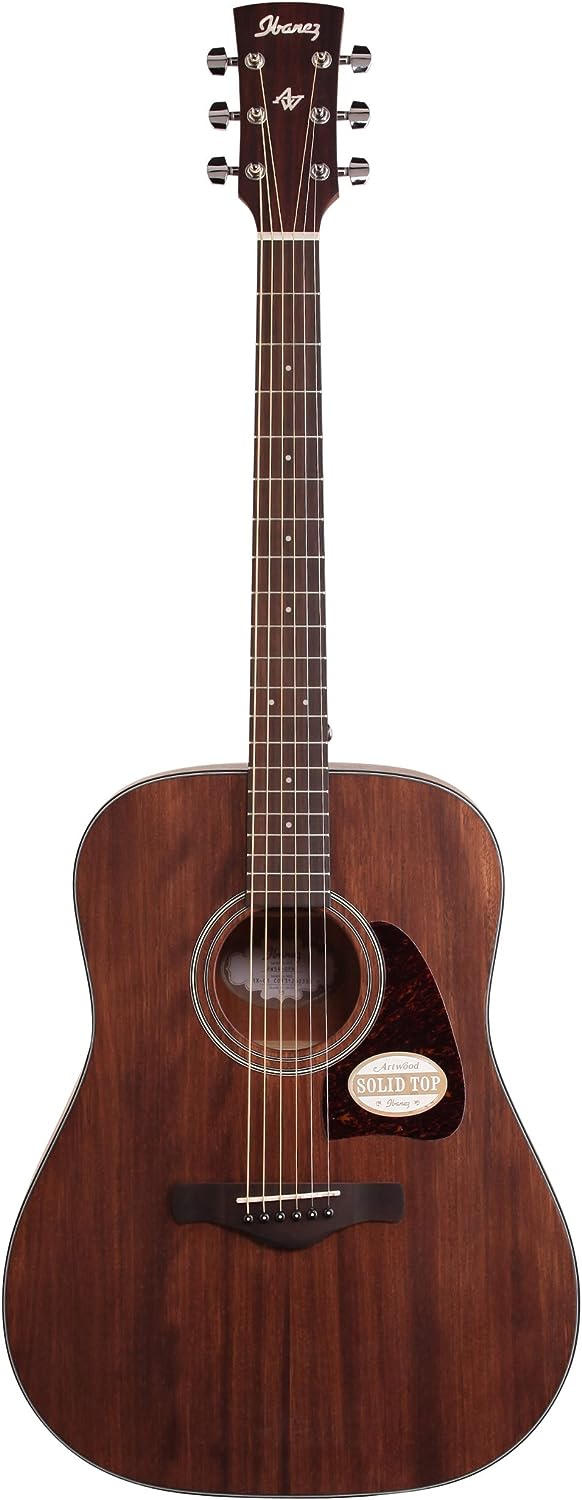
With its dreadnought body design, the Ibanez AW54OPN Artwood delivers a robust, resonant sound.
This particular guitar boasts a solid mahogany top, giving it not only aesthetic appeal but also contributing to its overall sound quality.
Accompanying this top are the guitar’s backs and sides, which are also constructed from mahogany.
The neck of the guitar adheres to this mahogany trend, providing a comfortable grip and smooth playability.
A standout feature of this instrument is its rosewood bridge and fretboard, yielding rich, warm tones that complement the mahogany construction perfectly.
The Ibanez Artwood Series has been carefully designed to blend tradition with modernity, offering a versatile and sought-after guitar tone.
The AW54OPN model comes with an Open Pore Natural finish that accentuates the natural beauty and grain of the wood.
Ibanez also incorporated their popular advantage bridge pins in this model, further enhancing the aesthetics and functionality.
While the case is sold separately, the guitar does include a tortoise shell pickguard, and easy-to-use chrome die-cast tuners.
All these features are harmoniously combined in the Ibanez AW54OPN Artwood, making it a guitar with both a remarkable feel and superior sound production.
- My Review
Upon picking up the Ibanez AW54OPN Artwood Dreadnought Acoustic Guitar, I immediately noticed its solid mahogany top, which was smooth to the touch.
Impressively, it is crafted with mahogany back and sides and a mahogany neck that enhanced its sturdy feel.
The warm color and texture of the rosewood bridge and fretboard added to the guitar’s overall aesthetic allure.
As I tested the instrument, I noticed that the dreadnought body provided a full-bodied tone while its solid mahogany construction offered a distinct, warm sound accentuated by deep, rich lows and sparkling highs.
One remarkable feature is its open pore natural finish, which beautifully showcases the guitar’s natural woodgrain.
As a die-hard musician, I understand that the ease and comfort of play are of paramount importance, and this guitar didn’t disappoint.
Its neck has a comfortable C shape that snugly fit into my palm, making it easy to navigate across the fretboard.
However, striking a balance between high performance and aesthetic appeal can be challenging, and there are areas where this guitar could improve.
For instance, this model tends to fall out of tune more frequently than others I’ve played, requiring more frequent tuning sessions which can be a bit tiresome, especially during extended playing sessions.
Also, the fret ends on the guitar I tested were quite sharp and protruded from the fingerboard in some areas, which could potentially cause discomfort during play.
Another potential inconvenience lies with the bridge pins, some of which can slip through completely during restringing.
Though this issue can be resolved by pushing them back out via the sound hole, it’s worth bearing in mind.
Despite these minor setbacks, the value this guitar offers is undeniably impressive.
To put it simply, the Ibanez AW54OPN Artwood Dreadnought Acoustic Guitar delivers extraordinary tonal quality and resonance, notably surpassing its price point.
With remarkable playability and remarkable resonance, especially on open chords, this guitar certainly has a place at any musician’s side, be it a beginner, intermediate, or seasoned player.
Sure, some adjustments might be necessary and regular tuning may be required, but these minor inconveniences are dwarfed by the guitar’s overall performance, making it a worthwhile investment for any music lover.
- Pros:
- Excellent sound quality.
- Comfortable and smooth neck.
- Durable and attractive design.
- Cons:
- Potential for fret buzz.
- Might require frequent tuning.
- Bridge may detach over time.
My final verdict is that the Ibanez AW54OPN Artwood Dreadnought Acoustic Guitar – Open Pore Natural is a remarkable blend of traditional design and modern technology.
With its solid mahogany top and rosewood bridge and fretboard, it delivers excellent sound quality and durability.
The Open Pore Natural finish emphasizes its elegance, making this guitar not only functional, but also visually appealing.
I am impressed by the Ibanez Advantage bridge pins, which enhance the guitar’s performance.
I highly recommend this guitar for both its “traditional yet modern” features and build quality.
Epiphone Hummingbird PRO Acoustic-Electric Guitar
Superior sound with solid spruce and mahogany build.
This guitar sports a solid spruce top with a mahogany neck and body. It’s equipped with Grover Rotomatic tuners, Fishman Sonitone electronics, and features an engraved ‘Hummingbird’ pickguard. Offered in a faded cherry color by Epiphone, it’s specifically designed for right-handed players with a fixed bridge system and piezoelectric pickup configuration.
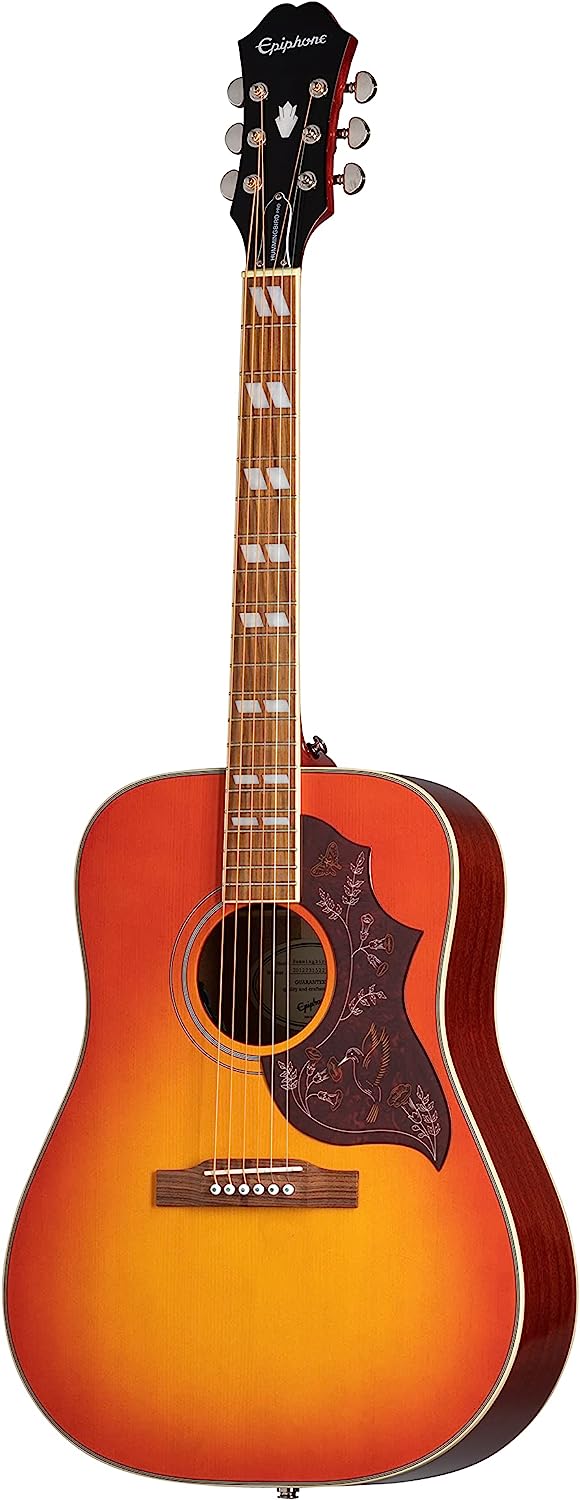
The product under discussion is an Acoustic/Electric Guitar by Epiphone, dubbed the ‘Hummingbird Studio’.
Its design is fashioned with a solid spruce top, giving it an attractive appearance while providing excellent sound resonance.
The neck and body of the guitar are made up of Mahogany, offering sturdy durability for extended use.
For tuning stability and precision, it employs Grover Rotomatic tuners which are highly revered in the industry.
To add to its visual appeal, a Hummingbird pickguard is incorporated into the design.
This guitar is also equipped with Fishman Sonitone electronics, aiding in its ability to project sound effectively when amplified.
The brand that produces this instrument is none other than the renowned Epiphone.
The guitar’s color scheme features a hint of Faded Cherry, giving it a distinct classic look.
The top of the guitar, as mentioned earlier, is made from Spruce, while both the body and the back are Mahogany.
The material used to make its neck also happens to be Mahogany and the fretboard is crafted from Rosewood.
Additionally, the guitar features a Piezoelectric pickup configuration, and is designed for right handed orientation.
Lastly, the Fixed guitar bridge system adds better sustain and tuning stability to this model.
The Epiphone Hummingbird Studio is a versatile guitar that bodes well for both acoustic and electric performances.
- My Review
Upon first seeing the Epiphone Hummingbird Studio Acoustic/Electric Guitar, its aesthetics catches your attention with its rich Faded Cherry color and the Hummingbird pickguard adding a touch of whimsy.
Featuring a Solid Spruce top, Mahogany neck, body and back along with a Rosewood fretboard; this guitar is not only visually striking but also constructed with durability in mind.
I was thrilled to find that the guitar has Fishman Sonitone electronics, and with Piezoelectric pickup configuration, the amplified sound is clear and rich.
One element that may require getting accustomed to is the Grover Rotomatic tuners, though they serve as a thoughtful addition enhancing the tuning stability and precision.
Additionally, the location of sound and tone control knobs on the inside of the guitar is unique, giving it a sleek exterior yet slightly complicating battery installation and cable removal process.
It’s worth noting that the Hummingbird comes fully set up, with spot-on playing height and intonation right out of the box. This certainly translates to less adjustment time, making it a more ready-to-play instrument.
The smaller diameter neck is reminiscent of the ease that comes with playing on a full-sized guitar which makes it especially favorable for women or children who are new to guitar playing.
One of the things I truly enjoyed in this guitar is the vibrant and bright sound it delivers when played, it surprisingly lived up to my expectation beyond its lightweight build and small neck.
When plugged into an amplifier, the sound becomes even brighter and more striking, indeed a testament to the quality of the onboard preamp and pickup.
As for the strap button, it was a bit bulky which may require larger strap holes, something to consider when getting a new strap for this guitar.
While the guitar generally meets the mark in terms of sound, build, and aesthetics, the electronically amplified sound for the high E string did seem to lack continuity with the rest of the strings.
As beautiful as it appears to be, a few minor imperfections in the paint and the pick guard cheaply represent some of the elements in the build quality.
Speaking of the electronics, they weren’t as consistent as I wished they were, with an absence of the battery in the initial pa*c*kage, and minor issues with its fittings.
All considered, the Epiphone Hummingbird Studio Acoustic/Electric Guitar holds its own both in terms of performance and aesthetics, notwithstanding a few minor quirks.
- Pros:
- Well-crafted with solid materials.
- Good saddle height and action.
- Attractive design and finish.
- Cons:
- May require initial setup.
- Battery insertion a bit hard.
- Specific strap needed due to design.
My final verdict is that the Epiphone Hummingbird Studio Acoustic/Electric Guitar is a high-quality instrument that meets all expectations for an acoustic/electric guitar.
Its spruce top and mahogany neck and body contribute to a rich and warm sound that impresses any listener.
The Grover Rotomatic tuners ensure accurate and easy tuning, enhancing the overall user experience.
Finally, the Fishman Sonitone electronics are top-shelf, ensuring a clear and powerful sound amplification.
Takamine GN93CE Acoustic-Electric Guitar
Versatile, high-quality guitar with distinctive sound.
This acoustic/electric guitar comes with a sleek NEX-style body and a unique three-piece back of rosewood and quilted maple, ensuring top-quality sound and a refined look. Embedded with a Takamine TK-40D preamp system, it offers increased versatility and sound control with its built-in tuner and multiple EQ and gain controls. The design is elevated with details such as maple body binding, dark wood rosette, and gold die-cast tuners with black buttons for a glossy finish.
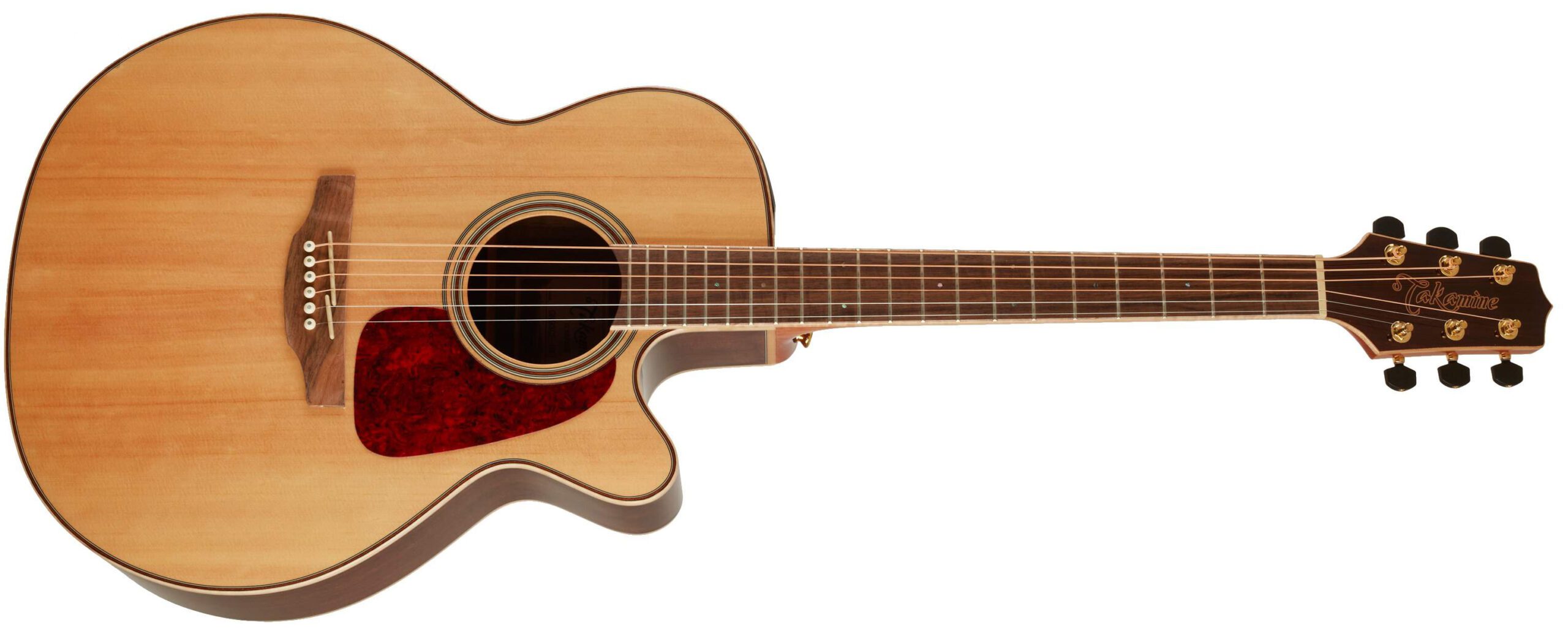
With its glossy natural finish, the Takamine GN93CE-NAT strikes an appealing balance of modern functionality and timeless elegance in an acoustic-electric guitar.
Boasting a unique NEX-style body shape that is both sleek and curvaceous, the guitar merges refined aesthetics and distinctive sound.
Adding to its premium feel, the guitar features a solid spruce top complimented by sides of durable rosewood and an exquisite three-piece back made of rosewood and quilted maple.
The comfortable feel and excellent playability of this instrument can be attributed to its slender mahogany neck and a bound 12”-radius rosewood fingerboard.
What sets this guitar apart is the advanced Takamine TK-40D preamp system, equipped with a built-in tuner, three-band EQ, and gain controls for optimal sound versatility.
These features, coupled with a mid contour switch, notch filter, and EQ bypass switch, offer unprecedented control over your sound’s quality and character.
Additional luxuries include maple binding on the body, neck, and headstock; dark wood rosette; synthetic bone nut and split bridge saddle; rosewood headcap; abalone dot inlays; gold die-cast tuners with black buttons; all beneath a glossy natural finish.
These features all contribute to the recognizable blend of upscale appeal and performance that this Takamine guitar embodies.
- My Review
Upon first glance, the Takamine GN93CE-NAT didn’t disappoint; the gloss natural finish delivers an aesthetic appeal that’s simply arresting.
Most apparent for me was the sleek and curvaceous NEX style body – a unique crafting choice that sets this guitar apart from its contemporaries.
One key feature I noticed was the delicate and exquisite mix of rosewood and quilt maple on the back, adding to its luxurious look.
I was instantly impressed by the solid spruce top and rosewood sides which indeed, provided a distinctive sound and an upscale feel.
Testing the guitar in my hands, I found that the slim mahogany neck along with the 12-inch radius bound rosewood fingerboard made for quite the cozy fit.
Playing it felt natural and fluid, thanks in no small part to its well-balanced design.
But the part that truly stole my heart was the customized Takamine TK-40D preamp system.
With a built-in tuner, three-band EQ and gain controls, the guitar made tuning and turning my desired sound into reality a breeze.
Further testing revealed a mid-contour switch and a notch filter, only adding to my delight with the guitar’s versatility and superior sound quality.
As an extra touch, the gloss finish and dark wood rosette gave the guitar a professional and balanced look.
The abalone dot inlays and gold die-cast tuners with black buttons added a touch of sophistication.
The GN93CE-NAT was a real treat to play, and I found the tone to be simply astonishing – it’s clear, from bottom to top, offering rich bass and high notes that didn’t sound tinny.
However, I will admit that I was slightly taken aback to learn that this beautifully crafted Japanese guitar was made in China.
Though this does not detract from the craftsmanship or the sound quality, it is something I wasn’t expecting.
Nevertheless, when it comes to value for money, this Takamine guitar is undeniably one of the best deals out there.
From its stylish aesthetics to its top-notch sound, this guitar left a lasting impression.
This isn’t just a low priced acoustic-electric replacement; it’s a professional-grade instrument that outdoes many of its competitors.
Whether you’re a fresh-faced beginner or a seasoned musician, you’re bound to find joy and satisfaction in the Takamine GN93CE-NAT Gloss Natural NEX Acoustic Electric Guitar.
- Pros:
- Excellent craftsmanship quality.
- Superior sound performance.
- Includes hardshell case.
- Cons:
- Neck might be thicker than expected.
- Some may prefer non-Chinese make.
My final verdict is that the Takamine GN93CE-NAT Gloss Natural NEX Acoustic Electric Guitar is a top-tier, noteworthy instrument, with exquisite attention to detail.
Its special design lends it an upscale feel and distinctive sound that sets it apart from other guitars at its price point.
The added special electronics, including the built-in tuner, deliver excellent versatility and sound quality.
Further enriching its aesthetic and performance are its premium features which provide great playability and serve as the cherry on top of this finely crafted musical treat.
So, if you are seeking a well-balanced guitar with great performance features and refined looks, this Takamine guitar should be given serious consideration.
Kadence Acoustica Series Acoustic Electric Guitar
High-quality, easy-to-use acoustic-electric guitar for all levels.
This semi acoustic-electric guitar marries high durability and ease of use, ideal for both beginners and professionals. It features quality strings, adjustable action, an 18:1 premium machine head for accurate tuning and a built-in preamp for amplified use. Notably, Kadence brings a variety of comfortable, functional acoustic guitars to feed your musical desires irrespective of your age or skill level.

The semi-acoustic Kadence Acoustica Series Guitar is expertly crafted from premium ash wood and finished with a deep pore paint, resulting in a stunning design where the head and body form a harmonious whole.
The instrument produces an impressive sound, thanks to high-quality strings that feature a special film coating to fend off rust and decrease the pressure required to press the strings, making it suitable for any guitarist over the age of 14.
It stands out for its adjustable action, possible due to a built-in truss rod that helps balance any tension induced by strings or temperature variations, ensuring a long-lasting and straight neck.
The adjustable neck also aids in maintaining a comfortable hand position and an excellent string height, making it a flexible choice for both juniors and adult players.
You’ll love the built-in preamp, as it comes with volume control, a two-band EQ for bass and treble, and even an integrated tuner for quick and easy tuning – a valuable feature especially for beginners.
Moreover, the Kadence semi-acoustic guitar comes with an 18:1 premium machine head, ensuring smooth tuning with high precision and stability.
A valuable inclusion is the pickguard, which can be placed under the guitar soundhole to protect it from pick scratches during performance.
Finally, Kadence is known for its commitment to delivering robust musical instruments that offer both functionality and comfort, and this semi-acoustic guitar is indeed true to that sentiment, promising to serve as a reliable companion throughout your musical journey.
- My Review
Having personally spent considerable time with the Kadence Acoustica Series Acoustic Electric Guitar, I can attest to the solid structure and splendid design of this instrument.
Bolstered with a smooth deep pore paint finish and beautifully engineered rosewood bridge, the guitar’s elegance is indeed eye-catching.
The guitar strings were lined up with a film coating which contributed to elongated usage and interestingly, reduced the pressure exerted on the fingers.
The pitch sound delivered by the guitar is satisfactory, made possible thanks to the tuning pegs which I found to be quite responsive and capable of maintaining the guitar in tune.
Embedded within the guitar is an adjustable truss rod, whose usefulness became apparent when I needed to counterbalance the tension resulting from string adjustments or temperature shifts.
I admit I was impressed by the position of the adjustable neck, which optimized comfort whenever I played the instrument.
The electric acoustic neck allows for numerous sound variations, accompanied with functional controls for volume, bass, and treble.
This instrument also comes equipped with an inbuilt tuner – an absolute lifesaver for those urgent tuning needs during a session.
Nevertheless, if you are keen on accurate and consistent tuning, you might find the inbuilt tuner somewhat challenging to read due to its rather small size.
Shifting focus to sound quality, I noted a better bass, volume and a fuller sound which is ideal for all range of music styles.
As a slight caveat, the guitar tends to be softer when played finger-style but picks up when strummed with a plectrum.
However, bear in mind that this is a feature, not a flaw, and will actually work to your advantage in scenarios that need you to switch between soft and loud playing.
If you are new to the world of guitars and are seeking to begin your journey, consider Kadence, they will help you express yourself through music, regardless of your age or skill level.
On a lighter note, don’t let the fancy design fool you into mistreating this delicate musical instrument – always remember to place the included pickguard beneath the soundhole to shield your guitar from probable pick scratches during your practices or performances.
As a caution though, you might want to remain vigilant while playing amped. From my personal experience, the guitar’s jackhole has the tendency to let the guitar amp cord slip out easily.
It’s safe to say the Kadence Acoustica Series Acoustic Electric Guitar promises reliable performance for both beginners and professionals alike.
- Pros:
- Premium Rosewood construction.
- Adjustable action for user comfort.
- Accurate tuning mechanism.
- Cons:
- Potential fret buzz issues.
- Included strings of lesser quality.
- Tuning pegs may not hold tune well.
My final verdict is that the Kadence Acoustica Series Acoustic Electric Guitar is an impressive instrument.
Its high durability and excellent sound quality make it suitable for both beginners and professionals.
The adjustable action and built-in tuner are practical features that make it even more user-friendly.
With its coated strings and carefully designed components, it is evident that this is a product of high quality.
Therefore, for anyone seeking a reliable, versatile, and exceptional guitar, the Kadence Acoustica is truly an investment worth considering.
Martin DJR-10E Streetmaster Acoustic Guitar
Dreadnought sound in a comfortable, playable size.
This right-hand orientation guitar is made of Sapale/Laminated Mahogany, a material renowned for resonance and durability. It comes with a comfortable, high-performance neck taper and a distinct distressed finish for an old, familiar feel. Equipped with state-of-the-art Fishman Sonitone electronics, it promises stunning onstage performance and studio recordings.
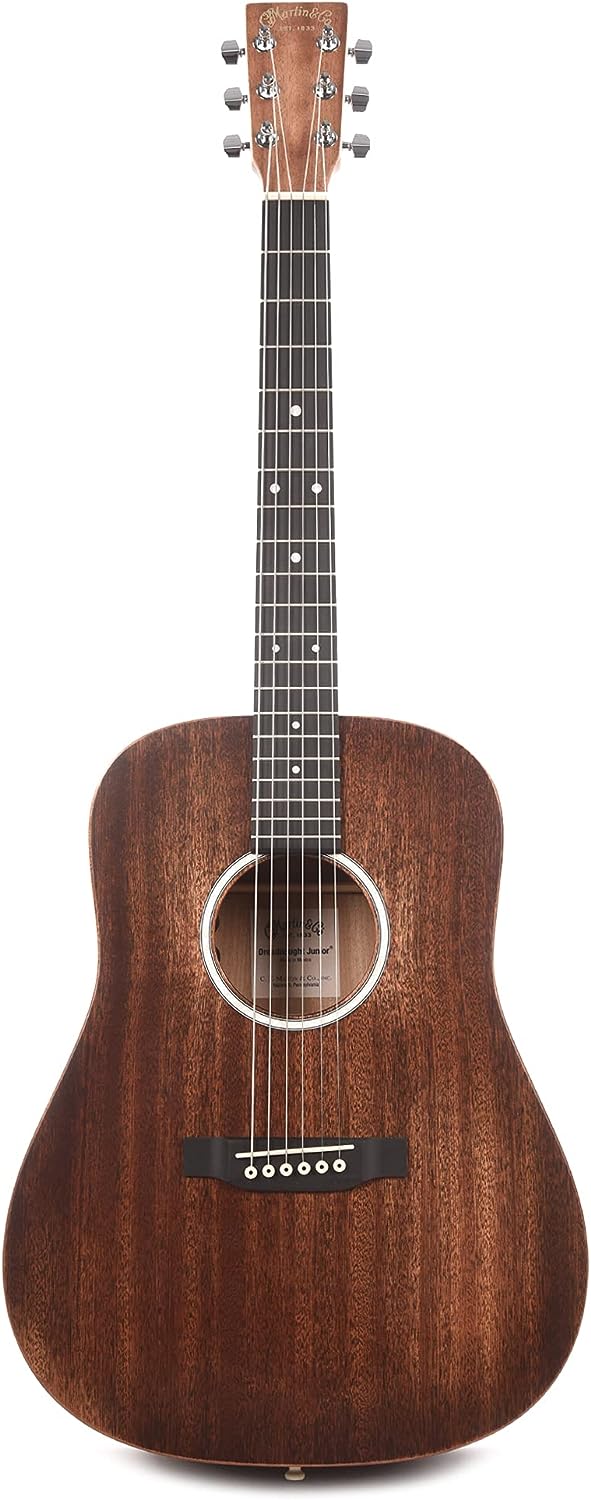
Made by the reputable brand Martin Guitars, the unique ‘Martin D Jr-10E Streetmaster Sapele Satin’ is specially designed with both the novices and experts in mind.
Constructed from Sapale Wood, the top, back, body, and neck of this guitar all boast this robust and reliable material, contributing to its superb playability and durability.
The right-handed orientation is perfect for the majority of players and boasts six strings for a versatile music experience.
This instrument measures 45″L x 18″W x 6″H, making it a smaller, more easily playable version of a traditional Dreadnought.
It also includes Fishman Sonitone electronics which allow you to easily connect and play in a variety of settings whether on stage or in the recording studio.
With its distinctive, distressed finish resembling a comfortably old, worn-out friend, this guitar doesn’t just look cool but is designed for comfort and playability.
DJR-10E StreetMaster has a thinner body and a high-performance neck taper for extended play times without reducing the sound quality, making it an ideal guitar for beginners, casual musicians, and performing artists alike.
It also includes a handy gig bag for easy transport and storage.
- My Review
On a visceral level, I was initially struck by the Martin D Jr-10E Streetmaster‘s distinctive, worn-out finish.
It renders an irresistible charm that speaks volumes about the unique personality of the instrument.
Immediately, it felt like a familiar friend I had been jamming with for years.
The shape and scope of the DJR-10E StreetMaster render it super-comfortable and playable.
Adding to this, the thinner body partnered with a high-performance neck taper makes it simply an ease to play, let alone hold.
As soon as I strummed the first chord, the Dreadnought size of the guitar delivered a booming, full sound that is par for the course for guitars of its category.
The six strings, made of quality material, lent an appealing vibrancy to the sound production.
Moreover, the guitar’s sapele wood construction augments its tonal quality, adding a warm midrange and a subtle top-end sparkle rendering it truly versatile across various styles and genres of music.
However, my experience with the guitar wasn’t entirely smooth sailing.
The Fishman Sonitone electronics intended to make plugging in and playing the instrument easier, were not particularly satisfying.
Upon amplifying the sound, the guitar’s sonic performance seemed to falter a bit, and was not as impressive as its acoustic performance.
It didn’t deliver the natural, organic experience I was hoping for and somewhat diminished the joy derived from strumming the chords.
On that note, it’s important to remember this is a guitar priced at less than a thousand dollars so there’s some degree of trade-offs.
You’re not exactly going to experience the sound quality of a four-thousand dollar guitar.
Still, I must commend Martin Guitars for their quality control.
They’ve produced a guitar that, albeit with a few minor glitches, has impressive features and manages to fit snugly into a decently-affordable price range.
Each chord resonated with the enduring legacy of Martin Guitars, yet simultaneously it wore a new-age appeal that sets it apart as a contemporary classic.
Ultimately, it’s about adjusting expectations and appreciating the guitar for what it brings to the table.
- Pros:
- Distinctive, distressed finish.
- Comfortable and playable.
- High-performance Fishman Sonitone electronics.
- Cons:
- Unnatural sound when plugged in.
- Lower quality compared to expensive models.
- Not recommended for acoustic model.
My final verdict is that the Martin D Jr-10E Streetmaster is a truly exceptional choice for music enthusiasts.
Its distinctive, distressed finish not only looks cool but adds a vintage vibe to your performance.
The comfort and playability provided by its thinner body and high-performance neck taper are really commendable.
Especially noteworthy is the presence of Fishman Sonitone electronics which allow for an impressive onstage or studio performance.
Whether you are a beginner or a regular gig player, this guitar is sure to elevate your musical journey.
Fender American Acoustasonic Jazzmaster Acoustic-Electric Guitar
Hybrid guitar with all-Mahogany body and neck.
This guitar showcases a hybrid acoustic-electric design with an all-mahogany body, neck, and top. Enhanced by an ebony fingerboard, it presents a natural look. Additionally, this product comes with a gig bag, offering a complete package for musicians.
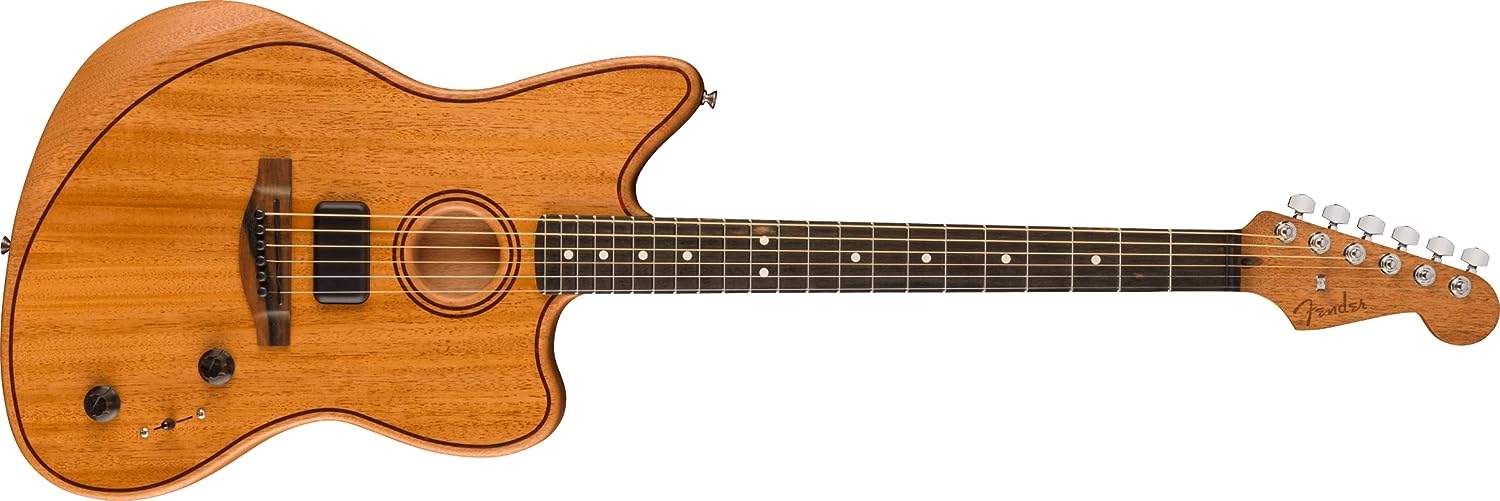
Furnished by Fender, this American Acoustasonic Jazzmaster marries the aesthetics of an all-mahogany, acoustic-electric guitar.
Its natural, tantalizing finish is complemented by a ebony fingerboard, adding a dash of elegance to its sturdy look.
There’s also a gig bag included, offering protection and easy transport for the instrument.
Its innovative, hybrid nature allows it to smoothly transition from an acoustic to an electric guitar, perfect for versatile musicians.
The guitar’s body, neck, and top are thoughtfully crafted from high-quality mahogany, providing rich resonance and warm tones.
The Jazzmaster’s design is iconic for its own style, and Fender has taken it a step further by adding a hybrid twist to it.
Its unique build, inspired by Fender’s rock-and-roll heritage, has been nicknamed the “Rebel Rocker”.
Captivating the attention with its rebellious vibe, this hybrid acoustic-electric guitar is a testament to Fender’s innovative prowess.
- My Review
As I strummed the Fender American Acoustasonic Jazzmaster All-Mahogany Acoustic Electric Guitar, I was greeted with a resonance and depth of tone that rivals that of many upper-end acoustic guitars.
Firstly, I was taken aback by the mahogany body, which produced a warm, rich tone when played acoustically.
Beyond the beautiful tone, the mahogany construction of the top and neck contributes to the guitar’s light weight, making it an excellent choice for extended play sessions.
When hooked up to my Line 6 amplifier and played electrically, I found myself completely consumed by its powerful, vibrant sounds as it capably handled every type of music I played on it.
The ebony fingerboard is another distinctive feature of this guitar, which doesn’t only look classy but also contributes to a smooth and enjoyable playing experience.
I have to confess, I spent hours just playing it acoustically through my Fender acoustasonic 40 amp and the sound was angelic, truly unbelievable.
Even without external amplification, the guitar’s natural acoustics were enchanting and pleasing to the ear.
Moving on to its design, it sports an all-mahogany natural look that renders it an object of tremendous beauty, making it not just a musical instrument, but also a work of art.
One point where I found room for improvement is the premium price-tag which might not be suitable for everyone’s pocket.
However, from my perspective, the quality and features that this guitar comes with justify its luxury pricing.
Not only can it replace multiple other guitars, but the joy and satisfaction of playing this masterpiece make it a worthwhile investment.
Personally, I’d say this Fender American Acoustasonic Jazzmaster All-Mahogany Acoustic Electric Guitar is among my favourite ones to play now.
Welcome relief was also found in its light weight and comfortable design, which made playing it for longer periods a pleasure rather than a chore.
To finalize, I state without hesitation, the Fender American Acoustasonic Jazzmaster All-Mahogany Acoustic Electric Guitar is an enchanting musical instrument that’s a joy to play and behold.
Exceptional in both aesthetics and performance, this guitar is a testament to Fender’s claim of “rebel rocker going hybrid”.
- Pros:
- Excellent acoustic and electric output.
- Lightweight and easy to play.
- High-quality, beautiful Mahogany construction.
- Cons:
- Relatively expensive.
My final verdict is that the Fender American Acoustasonic Jazzmaster All-Mahogany Acoustic Electric Guitar is a breakthrough product.
Being a hybrid acoustic-electric guitar, it gives users the flexibility to play a variety of music genres effectively.
Its Natural Mahogany body not only scores high on aesthetics, but also provides a richer and warmer tone.
The ebony fingerboard is well-crafted, which ensures comfortable and easier playing experience.
It’s a guitar that blends traditional craftmanship with modern features to offer an excellent guitar playing experience.
Taylor Academy 12e-N Acoustic-Electric Guitar
High-quality, beginner-friendly nylon string guitar.
The Taylor Academy Series Guitar is designed to enhance the experience of beginner guitar players, with a belief that new players deserve high-quality instruments. It features a comfortable and lightweight body, easy to play and strum, and produces a rewarding sound effortlessly. Additionally, it’s durable, unpretentious and covers a wide range of music preferences, making it ideal for novices.
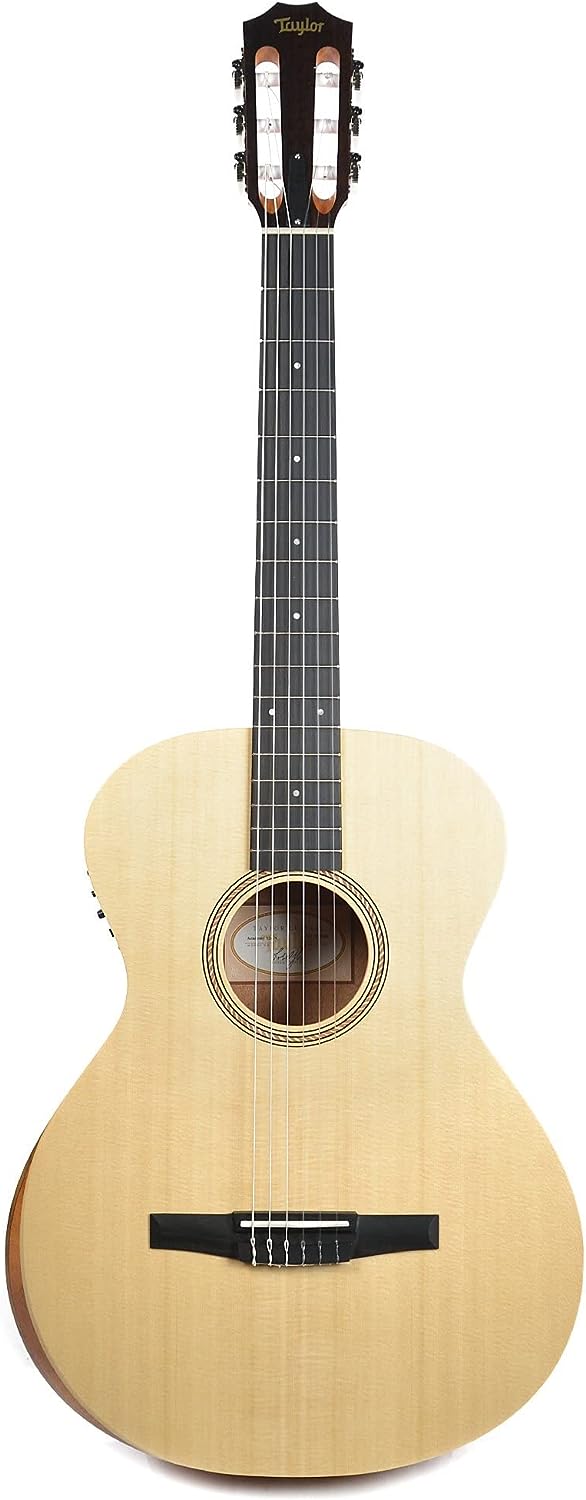
The Taylor Academy Series Academy 12e-N Grand Concert Nylon Acoustic Guitar Natural is built with a rich Grand Concert/OO body design.
This acoustic guitar does not feature a cutaway, and it’s crafted with solid Lutz Spruce at the top and layered Sapele at the back and sides.
Known for its Academy Series Nylon Bracing pattern, this guitar is finished with a Matte 2.0 Varnish on the body and is designed for right-handed players.
The neck of this guitar takes the Taylor Standard Nylon Profile, and it measures 1.875 in. (47.62 mm) at the nut width.
The fingerboard is made of genuine African Ebony while the neck is made from Sapele wood.
This guitar also features a scale length of 25.5 in., with a total of 17 frets, and the neck is also finished.
At its core, the Taylor brand passionately believes in providing a great playing experience for guitar players, regardless of their skill level.
They believe that guitar players deserve the best possible guitar, especially those starting out.
This is why the Academy Series Academy 12e-N Grand Concert Nylon Acoustic Guitar Natural is designed to be comfortable, lightweight, and easy to play, making it the ideal choice for beginner guitarists.
Furthermore, the sound it produces is incredibly rewarding and it’s not too fragile or intimidating for novice players to handle, and it can be used to play a wide range of music genres, making it a perfect choice for beginners to explore their interest in music in a more smooth and fulfilling way.
- My Review
I’m incredibly impressed with Taylor’s Academy Series Academy 12e-N Grand Concert Nylon Acoustic Guitar Natural.
It stands out as an instrument that not only caters to beginners but also to seasoned players, making it a truly versatile and value for money product.
What immediately struck me was its incredible attention to detailing, particularly the Solid Lutz Spruce top wood and the Layered Sapele back and sides.
It is great to have an acoustic guitar whose core materials are carefully chosen and meticulously put together.
As someone who appreciates quality craftsmanship, seeing such efforts taken in manufacturing a product is heartening.
The body finish is a Matte 2.0 Varnish which adds a polished and refined look, something I personally value in my guitars.
The Taylor Standard Nylon Profile neck shape and the Genuine African Ebony Fingerboard offers a comfortable and easy playing experience which enhances my playing sessions.
Of course, the sound quality is naturally a significant element when considering a guitar and Taylor hasn’t disappointed in this aspect as well.
It wonderfully blends richness and clarity, making every strum and pick sound fantastic.
Whether you are practicing alone, performing for a small audience or recording, the sound this guitar produces is reliable and consistent.
The ease of playability is also a strong feature, especially for beginners who can often find some guitars hard to hold or strum.
With this guitar, you can expect a smooth and effortless playing experience which will surely encourage you to keep honing your skills.
As per the product description given, Taylor has indeed taken significant steps to enhance the guitar-playing experience, and it shows with this particular model.
However, that’s not to say this guitar doesn’t have room for improvements.
I noticed a minor issue with the high e string producing an odd squeak when plucked up, which could be an annoyance to some, but can potentially be resolved with a quick visit to the guitar tech.
Despite this, the Academy Series Academy 12e-N Grand Concert Nylon Acoustic Guitar Natural still remains a high-quality product that resonates with Taylor’s passion for music and their dedication to improving the experience for guitar players.
- Pros:
- Quality sound and tone.
- Comfortable and easy to play.
- Great for beginners and professionals.
- Cons:
- Potential for string buzz.
- May have some build issues.
- Potential high ‘E’ string issue.
My final verdict is that… the Taylor Academy Series Academy 12e-N Grand Concert Nylon Acoustic Guitar Natural is an excellent choice for the beginner guitarist.
Offering a comfortable and lightweight design, it enables ease of use for those just starting their musical journey.
The guitar produces a rewarding sound even in the hands of a novice, contributing majorly to maintaining the interest of the player.
With its durable and minimal design, it doesn’t shy away from the rough handling expected from a beginner.
Moreover, it has a broad appeal, catering to the wide range of music preferences out there.
Guild F-2512E Acoustic-Electric Guitar
Jumbo twelve-string guitar delivers bright, full-toned sound.
The guitar is a jumbo acoustic-electric 12-string model, with a solid spruce top, maple sides, and an arched maple back for bright and full tones. It boasts Guild’s signature design for volume, projection, and long sustain. Included is a deluxe gig bag, along with built-in Fishman-designed AP-1 electronics and a natural satin polyurethane finish.
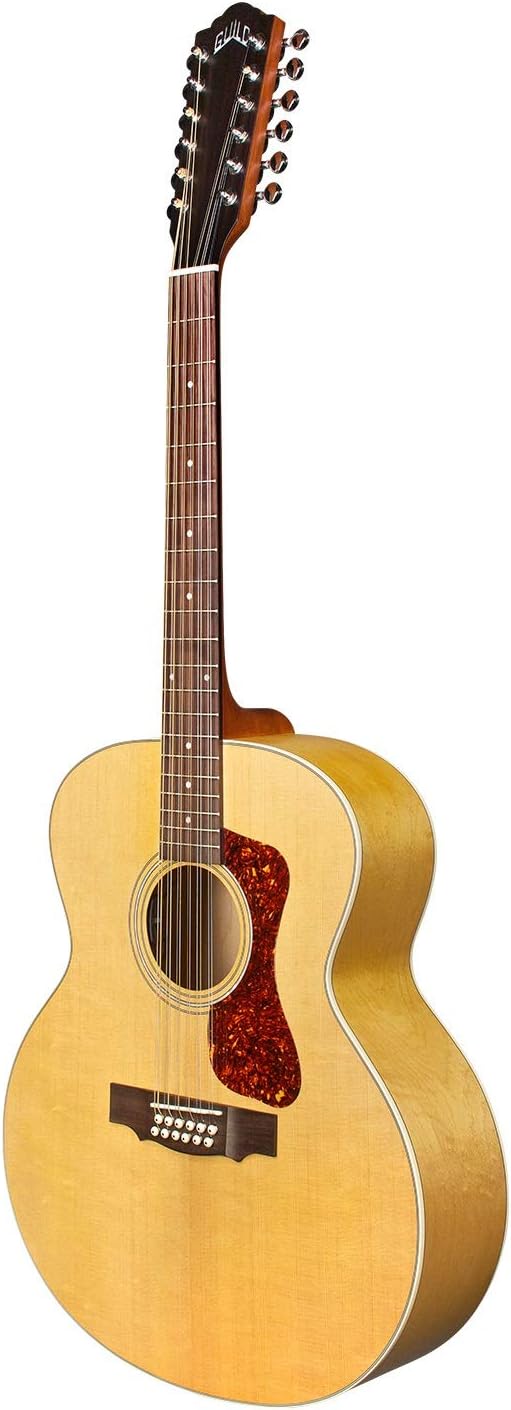
The Guild F-2512E Acoustic-Electric Guitar is housed in a jumbo frame, presenting a grand profile.
It comes crafted with a solid spruce top, sides of maple, and an arched back also made of maple, imparting the signature bright, ringing sound Guild’s twelve-string guitars are renowned for.
Characterized by a slim ‘C’ neck shape, the guitar boasts a nut width of 1 7/8”, which is quite comfortable to navigate.
Enhancing its visual appeal is a matte polyurethane finish, rendered in a natural shade, giving it a classic look.
The guitar also comes with a Guild deluxe gig bag for easy transport and storage.
The Guild F-2512E Maple is a perfect blend of two recognized Guild’s specialty areas: jumbo acoustic guitars and the 12-string construction.
The rounded bodies are iconic for jumbo acoustic guitars, and Guild has been generating excellence in this since its inception.
Created with maple and spruce, the F-2512E Maple bag features a vibrant sound typical of Guild’s twelve-string guitars.
The exclusive arched back design enables greater volume, longer sustain, and a rich, full sound.
Additionally, the guitar enjoys Guild’s Fishman-designed AP-1 electronics, a pau ferro fingerboard and bridge, bone nut and saddle, pearl rosette, and an historically accurate tortoiseshell pickguard.
Synonymous with quality and sound, the Guild F-2512E Acoustic-Electric Guitar is indeed a delight for the ardent guitarist, presenting a perfect blend of aesthetics and functionality.
- My Review
Having had the chance to get my hands on the Guild F-2512E Acoustic-Electric Guitar, there’s certainly a lot to unpack.
Without a doubt, the jumbo size of the guitar stands out and may not be a perfect fit for everyone.
My experience tells me that while some folks might appreciate the significance of the size, others may find it towards the larger side and alittle challenging to handle.
This being said, the solid spruce top, maple sides, and arched maple back creates a beautiful piece that boasts not just beauty but the bright, jangly tone characteristic of Guild’s twelve string guitars as well.
One of the other standout features of this guitar is the Slim C neck shape with 1 7/8” nut width.
If you’re like me, you’d find that it makes for easy and comfortable handling, particularly during those long practice sessions.
Aesthetically, the matte polyurethane finish in Natural adds a sleek, modern touch to the overall look of the guitar, which I am reasonably fond of.
One minor issue I encountered was with the guitar’s controls, which felt a bit loose and might require some additional adjustment or potentially even re-gluing.
All this aside, I noticed the guitar had a reasonably good setup right out of the box, though felt like the action may still require some fine-tuning to reach its peak playability.
Furthermore, there’s an element of satisfaction in the fact that it includes a deluxe Guild Gig Bag, effectively aiding in its portability and safekeeping.
On the down side, I did come across a few issues concerning the guitar’s intonation.
Particularly on the high and low G strings, it was off when playing certain chords, which slightly affected the sound quality.
Although a bit frustrating, it’s important to keep in mind that this can, and might need to be easily adjusted for optimum tuning.
Despite this minor setback, it’s essential to remember the unique characteristics this instrument offers.
The F-2512E Maple model successfully marries some of Guild’s most iconic specialties, specifically twelve string and jumbo guitars, forging a new path to richness in sound and quality.
- Pros:
- Impressive vocal acoustic instrument.
- Includes Guild’s Fishman-designed AP-1 electronics.
- Comes with a deluxe gig bag.
- Cons:
- Possible issues with electrical setup.
- Neck might be wide for some people.
- Problems with tension of 12 strings.
My final verdict is that the Guild F-2512E Acoustic-Electric Guitar is an exceptional choice for those who prefer a bright and jangly tone.
With its jumbo size and twelve-string construction, it sets a new standard for audio depth and richness.
The solid spruce top, maple sides, and arched maple back contribute to its robust sound and durability.
Moreover, the fact that it comes with a Guild deluxe gig bag indicates extra care for customers’ needs.
It offers great value for its price, especially for professional guitarists and enthusiasts who wish to level up their playing experience.
Yamaha A5R ARE Acoustic-Electric Guitar
Handmade acoustic-electric guitar with vintage appeal.
This acoustic-electric guitar features a solid Sitka spruce top and solid rosewood back sides, with a mahogany neck and ebony fingerboard for exceptional sound quality. Its vintage natural color and piezo pickup configuration add to its classic aesthetic. A right-handed, bronze-string instrument, it is handcrafted for a distinctive vintage vibe and robust voice.
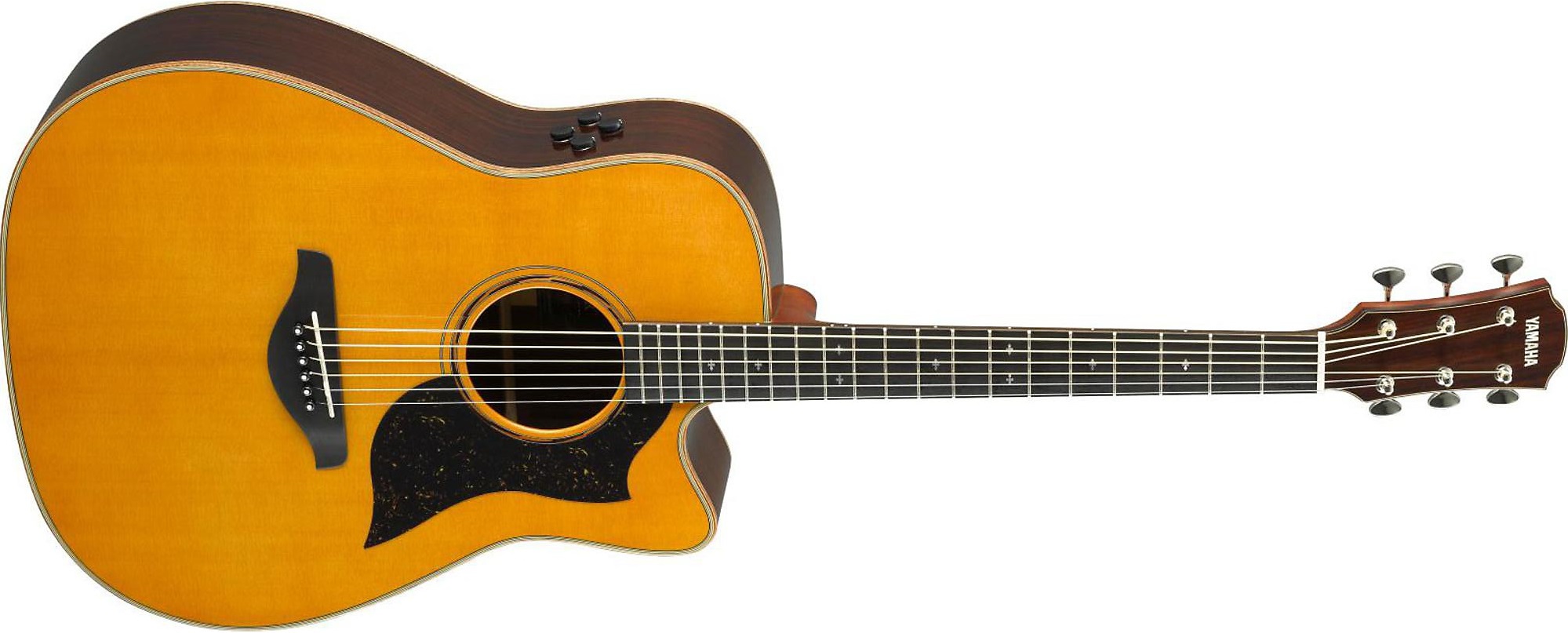
The Yamaha A5R ARE Dreadnought Cutaway is a masterfully crafted acoustic-electric guitar.
Boasting of a solid Sitka spruce top, the tonal quality and resonance that this guitar offers is truly top-notch.
The neck and fretboard are both made of Ebony, adding to the overall quality and the appeal of its vintage natural color.
Furthermore, the body and the back of the guitar are constructed with solid Rosewood that enhances sound quality and gives it a luxurious feel.
The neck of this guitar is made from sturdy Mahogany, ensuring longevity and durability.
One of the striking features is its Piezo pickup configuration, allowing the guitar to eloquently reproduce its acoustic tone while plugged in.
Apart from its quality construction, the Yamaha A5R ARE is designed for right-handed players and comes with Bronze strings.
This model, reflecting its vintage vibe, is versatile and offers a big voice, in line with its Solid-top handmade feature.
In essence, this guitar; a product of Yamaha, showcases a sublime mix of excellent craftsmanship, excellent materials, and a vintage aesthetic appeal.
- My Review
Upon first observation, the Yamaha A5R ARE Dreadnought Cutaway in Vintage Natural surely presents a grandeur that’s difficult to overlook.
Donning a solid sitka spruce top, combined with rosewood back and sides and a mahogany neck, the choice of materials gives the guitar an affluent aesthetic.
This guitar’s luxurious look is finalized with an ebony fingerboard, which adds a layer of distinction and elegance.
However, I must emphasize that the merits of this beauty stretch beyond its attractive appearance.
The most notable quality of this guitar is its remarkable sound.
With solid construction comes a solid sound, and solid sound it surely provides.
Distinctive tones, bold lows and crisp, clear highs, ring out with such clarity that it’s hard not to appreciate the craftsmanship behind this instrument.
Furthermore, paired with a Piezo guitar pickup configuration, the acoustics are significantly amplified, all the while maintaining its exceptional quality of sound.
As a musician, I appreciate instruments that are easy to play, and this guitar checks that box perfectly.
One of my favorite aspects is the instrument’s action, which is set up low, making playing a breeze and downright enjoyable.
Additionally, the guitar’s intonation is seamlessly perfect up and down the neck, further enhancing the ease of playability.
Another commendable feature in this guitar is the right-hand orientation, which, in my opinion, ensures an even more balanced output and efficient right-hand techniques.
The strings, crafted from sturdy bronze, lend a unique warmth to the sound, making it truly one-of-a-kind.
In terms of construction, the uncompromising craftsmanship is apparent in every detail of the guitar.
It’s not just a musical instrument, but also a well-designed piece of art.
This handcrafted instrument is designed with precision and an evident understanding of what musicians seek in their guitars.
Last but not least, I cannot overlook the beautifully detailed hard case that comes with the purchase.
Both practical and aesthetically pleasing, this case fits the guitar perfectly — ensuring it stays safe and sound when not in use.
So, after a careful examination and an extended “test drive”, I can honestly endorse the Yamaha A5R ARE Dreadnought Cutaway and recommend it to any music enthusiast who appreciates quality, craftsmanship, and superb sound.
- Pros:
- Superb acoustic and electric sound.
- Excellent Yamaha craftsmanship.
- Durable and versatile instrument.
- Cons:
- No significant negatives were found.
My final verdict is that the Yamaha A5R ARE Dreadnought Cutaway – Vintage Natural is an excellent choice for musicians looking for a high-quality instrument.
With its Solid Sitka Spruce Top and Solid Rosewood Back Sides, it produces a powerful and rich sound that is sure to impress.
The vintage natural finish and Ebony Fingerboard add a touch of classic elegance, making it a visually stunning addition to your collection.
Its Piezo pickup configuration and quality mahogany construction guarantee a long-lasting instrument with great acoustics.
This acoustic-electric guitar is an outstanding blend of fashion, function, and craftsmanship.
PRS Limited Edition SE P20E Parlor Acoustic-Electric Guitar
Compact parlor guitar with exceptional resonance and clarity.
This guitar offers exceptional tone and portability thanks to its quality materials such as solid mahogany top and laminated mahogany back sides. The Fishman GT1 undersaddle pickup system ensures a flawless performance, capturing natural vibrations without feedback. Additional features include a Wide Mahogany Neck with Ebony Fingerboard, herringbone rosette and a limited edition antique white finish.
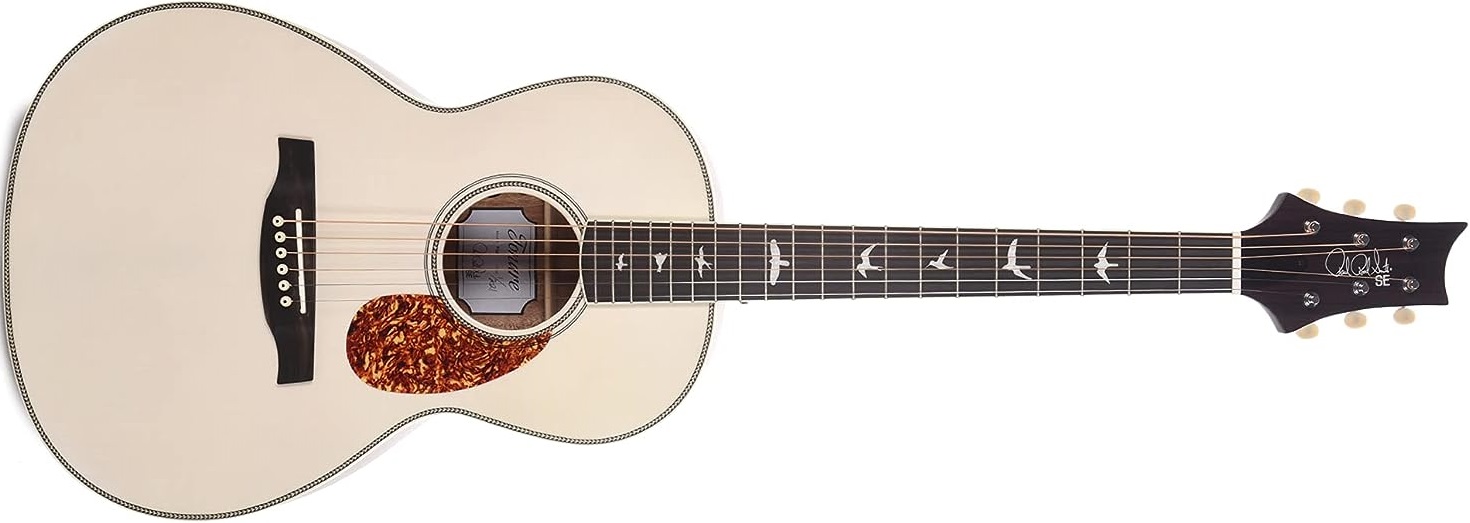
The PRS Limited Edition SE P20E Parlor guitar showcases a stunning Antique White finish with Fishman GT1 enhancements.
This guitar is not just a feast for the eyes; the premium materials used to craft it also mean it packs a punch with sound.
Ash, mahogany and ebony wood are used in the construction of the top, back, neck and fretboard materials which contributes to exceptional resonance.
Undoubtedly the most adorable feature of this guitar is its Parlor-size. Despite its compact size, it consistently produces a dynamically large voice and an impressive natural projection.
The guitar has a Piezo pickup configuration, houses six strings and is designed to be held in the right hand.
The solid mahogany top with hybrid X/Classical Bracing, along with the laminated mahogany back and sides, provide a level of sonic clarity that allows each nuance of your playing style to shine through.
Adding charm to the guitar are the iconic PRS Bird Inlays on the beautiful ebony fingerboard and a genuine bone saddle, further amplifying this guitar’s richness.
What sets the SE P20E apart is its Fishman GT1 pickup system that skillfully eliminates feedback and gives a faithful representation of your playing when amplified.
The controls are cleverly hidden within the sound hole, ensuring that they remain discreet during performance.
Also included with the guitar is a PRS Gig Bag.
- My Review
Seizing the moment, I carefully cradled the PRS Limited Edition SE P20E Parlor Antique White Guitar within my grasping hands.
Running my figures across the strings, its smaller body and shorter neck were instantly noticeable, providing welcoming comfort for individuals with physical challenges like arthritis or fibromyalgia.
However, the initial strumming makes evident the guitar’s saddle piece height, rendering the action a bit of a challenge to tackle.
Pausing for a moment, I also observed that it can be rather problematic to achieve right intonation owing to quality issues with the tuners.
Despite these initial setbacks, I can’t help but marvel at how transforming this guitar into a highly enjoyable instrument was merely a matter of lowering the saddle piece and investing in better quality tuners.
In its defense, the exquisite sound radiating from this guitar is truly impressive for its size.
Undeniably, the PRS Limited Edition SE P20E Parlor Antique White has distinctive bracing, presenting an appealing diversion from most other guitars in the arena.
This bracing element not only enhances its sound deliverance but also considerably lightens its weight, adding to the comfort for people with physical restraints.
However, it is not just its sound and comfort features that distinguish this guitar but also its striking Antique White finish.
Paired with a herringbone rosette and elegant accents adorning both the body and soundhole, the guitar is also a visual treat.
Even the choice of materials such as ash, mahogany, and ebony woods for the top, back, neck, and fretboard respectively, echo the quality that the brand, PRS, stands for.
Addressing practical concerns, the guitar comes equipped with a Fishman GT1 undersaddle pickup system.
This allows it to pick up natural vibrations accurately, effectively conveying your playing character when plugged in while minimizing feedback distortion.
Despite a few manageable drawbacks, the PRS Limited Edition SE P20E Parlor Antique White w/Fishman GT1 is a guitar that confidently delivers a potent blend of sound, style, and comfort.
- Pros:
- Lightweight and portable size.
- Powerful sound projection.
- Solid mahogany construction.
- Cons:
- Low quality tuners described.
- Action may require adjustments.
- Not as loud due to size.
My final verdict is that the PRS Limited Edition SE P20E Parlor Antique White with Fishman GT1 is a remarkable parlor guitar
This instrument delivers an exceptionally large dynamic voice and natural projection, defying its smaller size.
Its Rich Mahogany construction and genuine bone nut and saddle offers a unique tonal enhancement, combining to give a resonant and clear sonic output.
The Fishman GT1 undersaddle pickup system assures an enchanting performance while retaining the guitar’s aesthetic appeal.
I highly recommend this guitar for its perfect combination of portability, powerful performance, and charm.
Fender American Acoustasonic Telecaster Acoustic Electric Guitar
Acoustic-electric guitar with innovative shape-shifting tones
This hybrid guitar crafts ultimate sound versatility with 5 distinctive voice pairs, integrating both acoustic and electric voices. Its state-of-the-art design boasts a forearm and back contour, a mahogany Modern “Deep C” neck and an ebony fingerboard. Artfully crafted with Spruce wood, mahogany body, and phosphor bronze strings, it guarantees precision and performance for right-hand players.

The Fender American Acoustasonic Telecaster is a truly high-end acoustic electric guitar, boasting superb craftsmanship and a striking Sunburst finish.
The standout feature of this piece is its ground-breaking acoustic-electric nature.
The guitar not only offers traditional acoustic sounds but also has the ability to switch to electric tones, thanks to the innovative acoustic shape-shifting technology.
Part of its appeal is its collection of 5 unique voice pairs, a thoughtfully selected range of both acoustic and electric sounds, giving the player an unprecedented level of versatility.
The guitar also sports a Mahogany ‘Deep C’ neck and specially designed contours on the forearm and back for added comfort during play.
The brand behind this exceptional piece is none other than Fender, a name synonymous with quality in the music industry.
Its body, back, and neck are all crafted from Mahogany, while the top is made from Spruce wood, contributing to the guitar’s rich, warm tone.
The fingerboard is composed of ebony, enhancing sound clarity and offering a smooth playing experience.
This model is equipped with three types of pickups, N4 Magnetic, Fishman Under-Saddle Transducer, and Fishman Acoustasonic Enhancer, for a wider range of tonal options.
The string material is Phosphor Bronze, known for its bright, clear tone and durability.
Lastly, it comes with a gig bag for convenient storage and transport, making it the right choice for right-handed players.
- My Review
I am utterly enthralled by the Fender American Acoustasonic Telecaster Acoustic Electric Guitar.
Sporting a gorgeous sunburst design, its physical presentation is one for the books.
Not only is the guitar emphatically engaging to the eyes, but also to the touch, with an ebony fingerboard delivering prestigious smoothness.
As you venture further into playing this exquisite piece, you’d comprehend the ingenuity behind its cutting-edge acoustic-electric technology.
With five distinct voice pairs at disposal, the versatility this guitar displays is breathtakingly commendable.
Whether your go-to is a gentle, warm acoustic sound or you prefer a more visceral, electric beat; the Acoustasonic Telecaster will deliver beyond expectations.
Undoubtedly, the modern “Deep C” neck, constructed of mahogany, enhances comfort and cuts fatigue during prolonged sessions.
Furthermore, the integrated forearm and back contour exemplify the ergonomic intelligence in design.
However, there were some minor concerns I had while playing this guitar.
For instance, the high e string had a tendency to pop out of the nut, but this issue was quickly resolved by procuring the specific telecaster string guide.
Apart from that, there was an unexpected raised grain just below the sound hole that slightly disrupted the instrument’s otherwise sleek finish.
Despite that small hiccup, the guitar still exudes remarkable craftsmanship and quality with a spruce wood top and mahogany body.
And it does not stop at the remarkable aesthetics and performance; the guitar comes with a handy gig bag, adding to its portability.
Recharging your guitar is made simple with the integrated USB port, paired with a magnetic charging cable for added longevity.
String maintenance tips are also crucial, considering specific strings such as the Genuine Fender 860CL Phosphor Bronze Duratone Coated Strings enable optimal performance.
Most importantly, music reverberates from this guitar with its multi-faceted acoustic capabilities and rich electric tones, courtesy of the innovative collaboration between Fender and Fishman.
Indeed, this guitar serves as a powerful tool for musical expression, worth every penny of its price tag, and holds a special place in my arsenal of instruments.
While the guitar might not entirely replicate the sound of specific types, the sheer range of sound it can produce is nothing short of fantastic.
- Pros:
- Highly versatile guitar.
- Unparalleled tone and sound quality.
- Comfortable and easy to play.
- Cons:
- High E string may pop out.
- Quality of finish could be improved.
- Modeling may not match actual guitars.
My final verdict is that the Fender American Acoustasonic Telecaster is a cutting-edge, versatile instrument.
This acoustic-electric guitar is revolutionary in its design and functionality, offering shape-shifting acoustic and electric tones.
The integration of a mahogany “Deep C” neck, forearm and back contour adds great value to the overall product experience.
Furthermore, with its Fishman-designed Acoustic Engine, it delivers a fresh sonic expression in any setting, from studio to stage.
All these features make it a solid choice for guitarists looking for value, versatility, and innovation.
Yamaha Storia III Acoustic Guitar
Stylish Yamaha guitar with strong, earthy tonality.
The Yamaha Storia III Acoustic Guitar shows off an earthy, midrange tonality, luminous gloss finish, and statement-making mix of black, wine red, and ivory inlays. Its solid mahogany build promises durability while champagne-gold tuners add a touch of luxe. With a comfortable walnut neck and hand-rolled fingerboard edges, it’s designed for easy playability, inviting in creativity and self-expression.
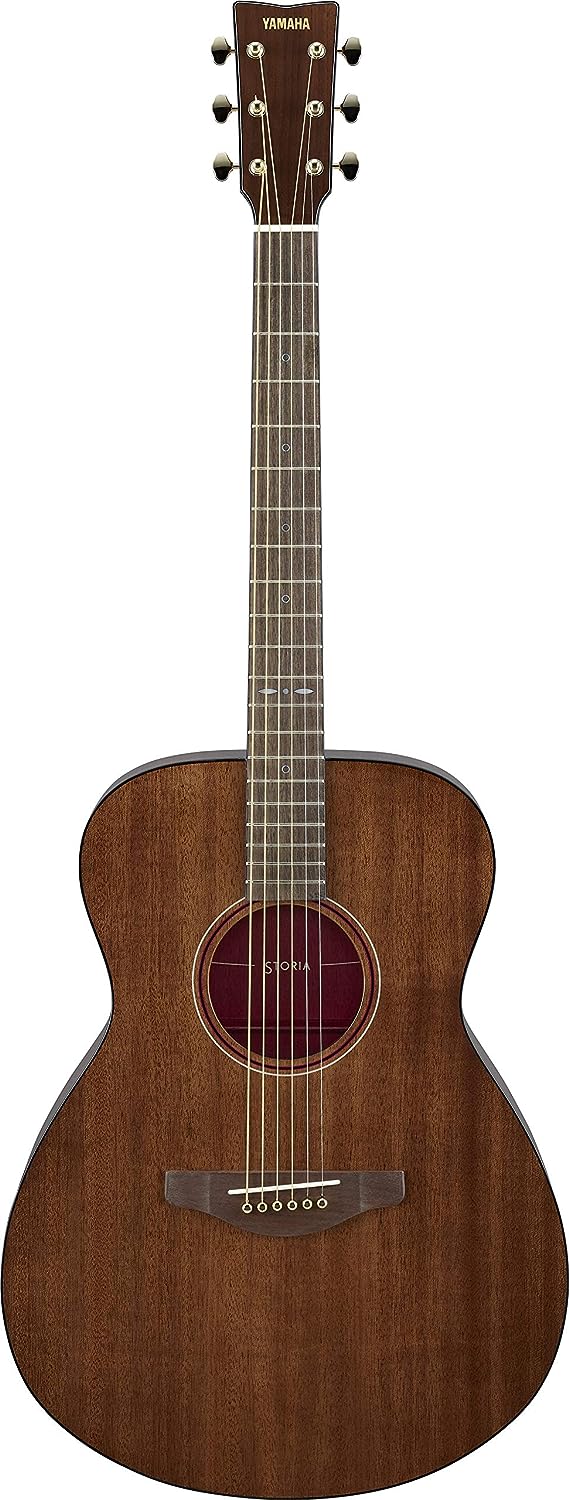
The Yamaha Storia III Acoustic Guitar comes in a rich, chocolate brown color that gives it a distinct and appealing look.
What sets the guitar apart is its clear midrange tones, which are robust and bold; this is due to the solid mahogany top.
Apart from this, the mahogany used in the back and sides amplifies the strength and quality of the sound produced.
Its interesting color palette, which includes black, wine red and ivory, is further enhanced with an inlay design to create a unique aesthetic.
Adding to the visual appeal is the luminous gloss finish of the guitar, ensuring it stands out in any setting.
The Storia series from Yamaha encourages creativity and brings a dynamic edge to any space it’s in.
More than just its eye-catching appearance, the unique finishes, sparkling inlays, brass additions, and striking champagne-gold tuners give it a strong character.
It’s not just about looks; the guitar is also designed for comfort. The slim walnut neck, the ideal string height, and hand-rolled fingerboard edges make it easy for anyone to play.
In essence, the Yamaha Storia III Acoustic Guitar is not just an instrument; it’s a beautiful addition to your home that inspires creativity and personal expression.
- My Review
Having experienced the joys of the Yamaha Storia III Acoustic Guitar, Chocolate Brown, I can genuinely express my admiration for it.
The craftsmanship of the guitar is admirable and exudes excellence, which is clearly evident in its beautiful aesthetics and smooth, comfortable playability.
One notable feature of the guitar is its solid mahogany top married to mahogany back and sides, which not only add to the aesthetic appeal but also contribute significantly to its impressive and uniquely earthy midrange tonal character.
What’s more, the guitar has a noteworthy feature that truly stands out – its inlays in vibrant colors of black, wine red, and ivory that add a striking contrast to the earthy chocolate brown body.
This beauty is further enhanced by a luminous gloss finish, which gives it a glistening appeal that is irresistibly inviting.
During my play sessions, I could feel the convenience of the slim walnut neck, low string height, and the edges of the fingerboard that have been hand-rolled.
I must add that the guitar’s balance, which is an important factor for any seasoned player or a beginner, is meticulously achieved.
Regardless of the duration of my playtime, it stayed in tune and kept the intonation perfect.
On a more personal note, I found the body shape accommodating, which made each play session comfortable and irritation-free.
Though the guitar has a smaller body, it does not compromise on the sound; the lower-end sound is slightly less but it still manages to have a rich, full tone.
I must point out that the strings felt a bit hard, so they might cause some finger fatigue for those who have not yet developed hardened fingertips.
As for the tone, it’s somewhat bright – a characteristic that some may prefer, while some might find it too sharp.
However, all these are minor aspects that can be easily adjusted according to personal preference.
In terms of room for improvement, I believe an active pickup with volume and tone control could be a great addition.
Lastly, the champagne-gold tuners are more than just visually striking; they are a testament to the overall quality and attention to detail put into the product.
Additionally, if you value guitars that stay in tune for extended periods, the Yamaha Storia III is a stellar contender.
Moreover, for those attracted to smaller guitars, whether for aesthetic purposes or simply more comfortable handling, this would be an excellent choice.
The Yamaha Storia III is not only a guitar, but also a path to creativity, self-expression and a beautiful addition to one’s living space.
- Pros:
- Excellent craftsmanship and sound.
- Comfortable to play and balanced.
- Comes with passive pick up.
- Cons:
- Bright tone might be overpowering.
- Potential issue with high action.
- String substitution may be required.
My final verdict is that the Yamaha Storia III Acoustic Guitar, Chocolate Brown is an absolute gem.
Its ability to deliver a strong, earthy midrange tonality coupled with its statement-making finishes make it a standout addition to any living space.
The comfortable string height and hand-rolled fingerboard edges encourage spontaneous play and foster creativity.
Not only is it visually stunning with its shimmering inlays and champagne-gold tuners, it is designed to provide a new, highlighted path to self-expression.
The Yamaha Storia III encapsulates not just quality craftsmanship, but also a beautiful interplay of aesthetics and sound.
Martin SC-13E Acoustic-Electric Guitar
Premium Acoustic-Electric Guitar with Spruce Top, Koa Sides.
This 6-string acoustic-electric guitar features a spruce top with koa fine veneer back and sides. The neck is crafted from select hardwood, complementing an ebony fingerboard. It showcases the authenticity of Martin’s acoustic strings, additionally offering LUXE, signature, folk and Darco strings along with a host of guitar care accessories.
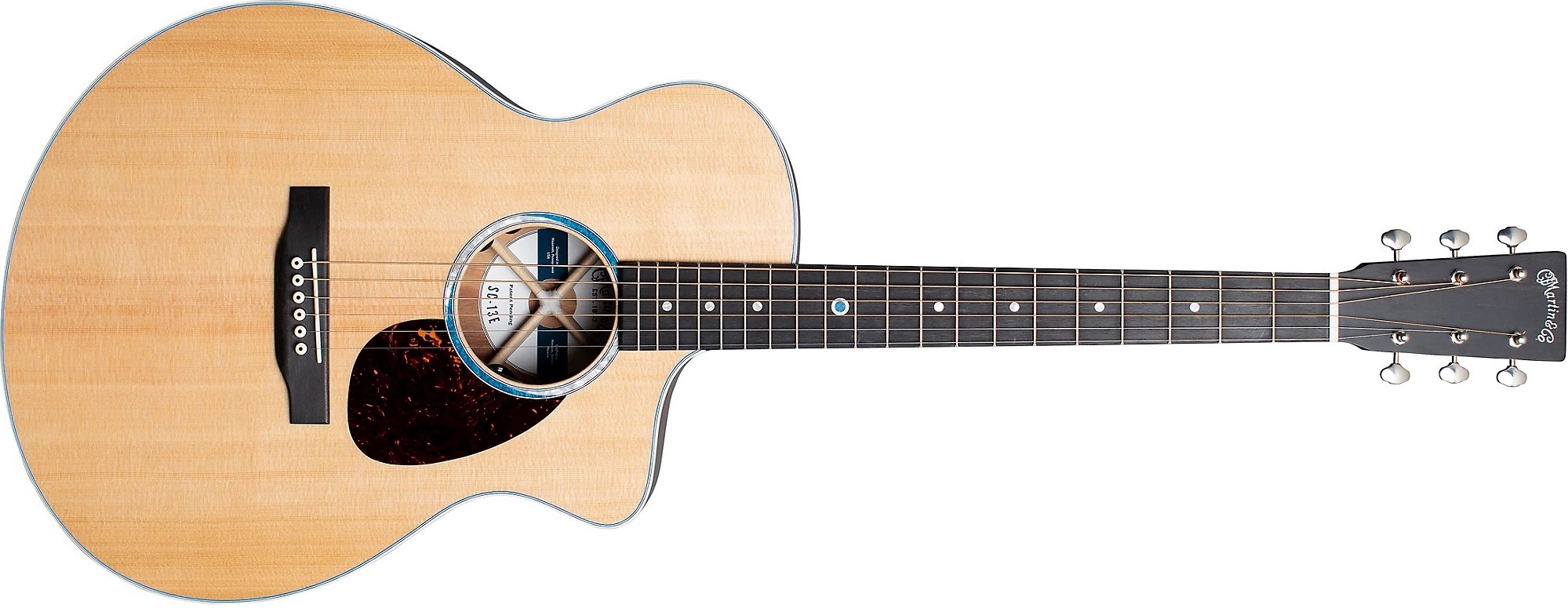
Martin SC-13E is an exceptional blend of an acoustic and electric guitar.
The six-string instrument comes with an exquisite spruce top, which chiefly contributes to the overall visual aesthetics of the guitar.
One of the most striking features about this guitar that sets it apart is its back and sides crafted from Koa fine veneer.
The shiny ebony fingerboard adds not just a touch of class but also promises a fantastic playability experience.
Natural finish on the guitar gives it a sophisticated and rustic charm.
Moreover, the SC-13E sports a select hardwood neck, providing a solid grip for a smooth performance.
To accompany the guitar, Martin offers Authentic Acoustic Strings designed to produce superior resonance and tone.
Also included in the package are Martin’s proprietary range of LUXE and Signature Strings.
For folk music enthusiasts, the guitar also supports Folk and Darco Strings.
Lastly, Martin provides extensively for the care and longevity of your instrument with their range of Guitar Care and Accessories.
- My Review
I had the opportunity to enjoy the Martin SC-13E Acoustic-Electric Guitar and am thrilled to share my experience.
This model boasts a beautiful Spruce top that not only enhances the aesthetic appeal but also contributes to the vibrant tones of the guitar.
The Koa fine veneer back and sides are a significant addition, infusing each note with warmth and a glowing resonance that is true to the Martin sound heritage.
Further enhancing the player’s experience, the Ebony fingerboard and select hardwood neck provided me with surprising comfort and ease of navigation.
Playing this guitar, I found the tones clean, and the volume and tone tuner in soundhole proved to be an efficient feature.
It is worth mentioning that I was initially uncertain about the gig bag, but its plush construction quelled my concerns; it is not for touring but effective for safekeeping and transport nonetheless.
However, I must point out a few areas where I believe this model could have served better.
I observed that the action of the guitar, out of the box, was not up to the standard I expected.
Even though the guitar featured an innovative neck design meant to facilitate quick adjustments, adequate shims for the process were not included.
This necessitated a substantial effort to alter the action and fix the alignment, a slight drawback in my playability experience.
Meanwhile, the unique cutaway design allowed me to reach the upper frets with a smoothness that was quite agreeable.
Despite the uncertainty about the action adjustment, I admire the compact dreadnought size, translating to comfort in playability, and the plush, backpackable gig bag added to the convenience.
On a finishing note, while I did notice a few slight hitches, Martin’s commitment to quality and authenticity remained very much evident in the Martin SC-13E Acoustic-Electric Guitar.
- Pros:
- Exceptional tone and sound quality.
- Compact design, with reachable upper frets.
- Equipped with built-in tuner and pickup controls.
- Cons:
- Potential alignment issues with neck design.
- Lack of Martin provided shims for easy adjustment.
- Thin top could be problematic in low humidity environments.
My final verdict is that the Martin SC-13E Acoustic-Electric Guitar is a fantastic purchase for both amateur and professional musicians.
The instrument’s Spruce Top and Koa Fine Veneer Back provide a unique, aesthetic appeal as well as top-class durability.
The Ebony Fingerboard contributes to an unparalleled playing experience, ensuring a smooth and speedy action.
Combined with its Select Hardwood Neck, the guitar is incredibly comfortable to hold and play for extended periods.
Lastly, the availability of the brand’s LUXE & Signature Strings, Folk & Darco Strings, and Guitar Care & Accessories make it a very practical choice.
Taylor AD17e Blacktop Acoustic-Electric Guitar
High-quality sound with spruce top and ES2 electronics.
This blacktop 6-string acoustic-electric guitar offers the Taylor American Dream experience with a spruce top and ES2 electronics. It features a smooth eucalyptus fingerboard with ovangkol back and sides and a sturdy mahogany neck. The guitar represents a new era of value and performance in Taylor’s lineup.
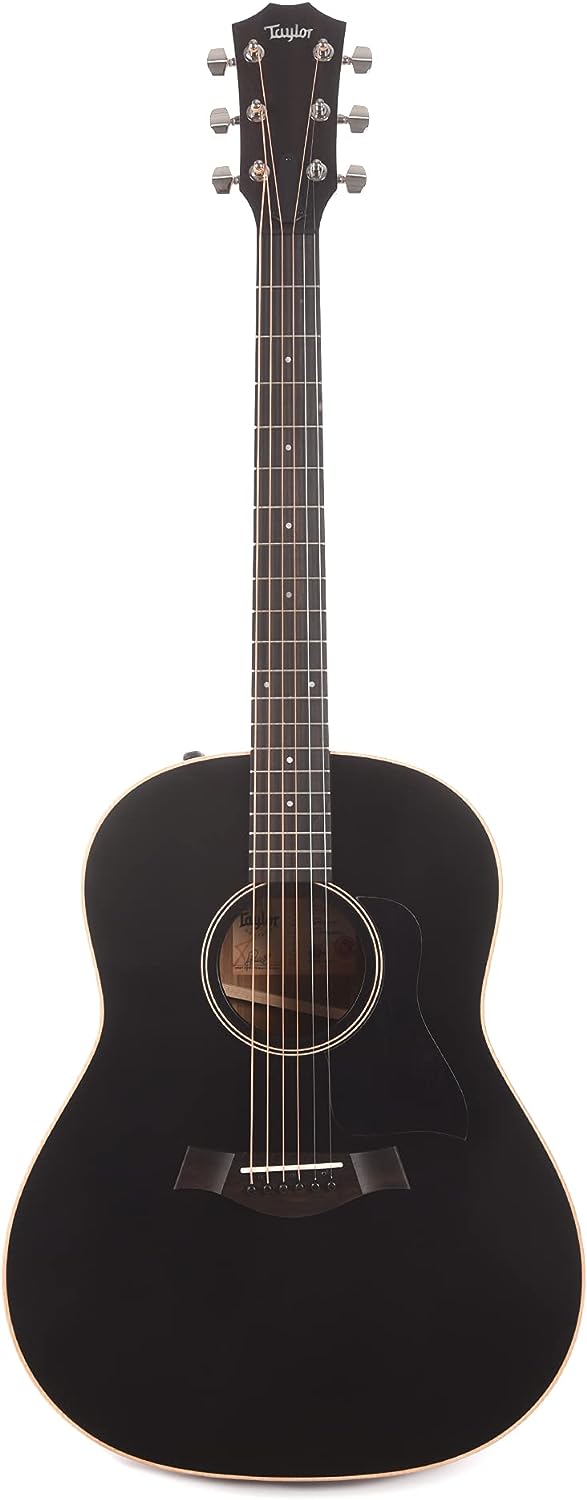
This Taylor American Dream AD17e is a wonderful fusion of electric and acoustic elements, sporting a chic Blacktop color for a modern touch.
Being a 6-string guitar, it provides a robust range of tones, capable of delivering melodies both mellow and vigorous alike.
The body is adorned with a Spruce top, a choice wood often praised for its rich sound and resilience.
To complement the top’s Spruce, the guitar is furnished with Eucalyptus on the fingerboard which is sturdily designed to withstand prolonged playing.
An integral part of the guitar’s design is its ES2 Electronics. The technology incorporated distinctly amplifies the sound without distorting its natural acoustic resonance.
Adding further to its construction are the Ovangkol back and sides. Ovangkol is a unique wood combining the warm tonal characteristics of Rosewood with a striking grain, providing additional layers to the guitar’s sound profile.
Lastly, the guitar’s neck, crafted finely out of Mahogany, adds persistence and stability to the instrument, assuring a comfortable hold and excellent playability.
In brief, this model represents a promising leap in Taylor’s comedy of instrument design, tactfully balancing elite performance and affordable value.
- My Review
Upon my first encounter with the Taylor American Dream AD17e Acoustic-electric Guitar, I was instantly captivated by its unique Blacktop finish.
As a discerning musician, I highly appreciate the distinctive tonal clarity attributed to its spruce top.
Beyond its aesthetically pleasing design, the guitar’s performance, backed by the integrated ES2 Electronics, made a strong impression.
I found this feature particularly handy when desiring to amplify or adjust the instrument’s sound for various contexts.
While playing, my fingers relished the gentle touch of the eucalyptus fingerboard.
Not only did this enhance my overall playing experience, but it also imparted a fresh and organic flavor to the instrument’s design.
Holding it in my hands, the guitar exhibited a reassuring heft, thanks to the ovangkol back and sides.
Far from making it cumbersome, this solidity added a robust durability that suggested it could withstand extensive use.
What I found most comfortable, however, was the mahogany neck.
Not only was this agreeable to hold, but it also facilitated smooth transitions between chords and, in turn, brought fluidity to my playing.
Firmly cradled in my hands, the pleasant warmth of the mahogany neck significantly eased those prolonged practice sessions.
Exploring the diverse range of tones enabled by the Taylor American Dream AD17e, I found it to be a versatile partner serving a broad spectrum of musical styles.
From soft, mellow strums to vibrant resonations, without missing a beat, this acoustic-electric guitar managed to capture each shade of expression I aimed for.
It’s important to note that the guitar, while being fairly valuable, presents an exceptional level of craftsmanship and performance.
As such, I found it to be a worthy investment for any avid musician who may be looking to enhance their instrumental repertoire.
Despite its many merits, I must point out that mastering this instrument can take time and practice, especially for beginners.
However, the final output and depth of sound it assures are undoubtedly worth every bit of effort.
Delving deeper into the many nuances of the Taylor American Dream AD17e Acoustic-electric Guitar has been nothing short of a rewarding journey for me.
Given its capabilities, this instrument can indeed be described as a new chapter in Taylor’s value and performance.
- Pros:
- 6-string Acoustic-electric Guitar.
- Spruce Top ES2 Electronics.
- Eucalyptus Fingerboard.
- Cons:
- Price may be high for some.
My final verdict is that the Taylor American Dream AD17e Acoustic-electric Guitar – Blacktop gives the perfect mix of affordability and quality.
Its Spruce Top ES2 Electronics and Eucalyptus Fingerboard enhance tone and playability.
The Mahogany Neck and Ovangkol Back Sides add a touch of luxury to it.
This guitar is a symbol of outstanding value and performance, worth every penny.
What to Look for When Buying Acoustic-Electric Guitars?
When you’re in the market for an acoustic-electric guitar, there are several factors to consider that can help you make the right choice.
The first consideration should be your own personal musical style and requirements.
This is because the type of music you play could heavily influence the type of guitar that would best suit your needs.

For example, if you typically play hard rock or heavy metal, you might prefer an acoustic-electronic guitar with a cutaway design and a thin body that allows for easier access to the higher frets.
On the other hand, if you primarily play folk or country music, a traditional dreadnought or grand auditorium-style guitar may be more appropriate.
Moving onto the second factor: the sound quality.
The sound, or tone, of a guitar depends mainly on the guitar’s construction and materials.
A guitar made of solid wood usually produces a richer sound than one made of laminate or a composite material.
The system of pickups and preamps, which are responsible for amplifying the guitar’s sound without distorting it, is another crucial aspect to consider.
An inadequate pickup or preamp can drastically lessen the quality of the guitar’s amplified sound.
The third variable to consider is the playability of a guitar, which refers to the ease with which it can be played.
This includes factors like the action, or height of the strings above the fretboard, the width and contour of the neck, and the size and shape of the body, to name a few.
You may want to consider how comfortable the guitar is to hold and play for extended periods.
Another consideration is the fit and finish of the guitar, which speaks to the quality of its construction.
Inspect the guitar closely for flaws in the finish, issues with the binding, loose braces, or other signs of poor craftsmanship.
High quality acoustic-electric guitars typically have detailed and clean craftsmanship.
Finally, make sure to consider the price within your set budget.
There are acoustic-electric guitars available at various price points, and typically the cost goes up with the quality of the materials used and the level of craftsmanship.
However, there are also many affordable guitars that offer a great value for the price, and with careful shopping, you should be able to find one that fits your needs and your budget.
Just remember, a higher price doesn’t always guarantee a better guitar, so try a variety of guitars in different price ranges to see which one feels and sounds the best to you.
Considering your own musical style and requirements, the sound quality, the playability, the fit and finish of the guitar, and of course, your budget will all be key factors in finding your best fit in an acoustic-electric guitar.
While it might seem like a lot to remember, once you start playing different guitars, you’ll quickly start to understand what works for you and what doesn’t.
With all these considerations, you are well on your way to choosing the right acoustic-electric guitar.
How Do You Maintain an Acoustic-Electric Guitar?
Acoustic-electric guitars require specific maintenance practices to ensure longevity and preserve the quality of sound they produce.
One crucial aspect in maintaining an acoustic-electric guitar involves regular cleaning.
By using a soft, lint-free cloth, one can wipe down the entire guitar after use to eliminate fingerprints, dust, and sweat that could corrode the strings and guitar body.

A guitar-specific cleaning product is recommended for more thorough cleanings, as it’s designed to protect and nourish the guitar’s wood and finish.
A neglected aspect of maintenance that still is really vital is humidifying the guitar.
Wooden instruments like acoustic-electric guitars can crack or warp if the air is too dry, so it’s recommended to use a guitar humidifier, especially during the winter months when indoor air tends to be dry.
String care is another excellent aspect of maintaining an acoustic-electric guitar.
Old or dirty strings not only sound dull but can also cause wear to the guitar’s frets, so it’s recommended to change strings regularly based on how often you play.
You should also clean guitar strings periodically with a string-cleaning product to extend their life and keep them sounding vibrant.
Then there’s fretboard care.
Most fretboards are made of untreated, porous wood, and they can dry out over time, leading to cracking or warping.
It’s advisable to use a specially designed fretboard oil to nourish the wood and keep it from drying out.
Furthermore, the electronics in an acoustic-electric guitar require their own specific care.
Dust or dirt can affect the performance of the guitar’s pickup system and controls, so it’s a good idea to use compressed air or a small brush to clean these areas.
Moreover, sweat and oils from your fingers can corrode metal parts like the output jack and control knobs, it’s beneficial to wipe these parts clean after each use.
Last, but certainly not least, is proper storage of your acoustic-electric guitar.
Excessive heat, cold, or moisture can damage a guitar over time, so it’s best to store the guitar in a case in a room that’s at a consistent, moderate temperature and humidity level.
Also, avoiding direct sunlight can help prevent the guitar’s finish from fading.
An acoustic-electric guitar is an investment that, with the right maintenance practices, can provide a lifetime of enjoyment.
The critical factors in maintaining a guitar include regular cleaning, humidifying, string care, fretboard care, electronics care, and proper storage.
By taking a little time and effort to care for your guitar, you can ensure it remains in top condition and continues to provide the rich, clear sound that acoustic-electric guitars are known for.
What are the Typical Materials Used in These Guitars?
The materials used in constructing acoustic-electric guitars play a significant role in their sound, durability, and aesthetic appeal.
Wood is the primary material used in their construction due to its ability to produce a unique and rich sound.
Various types of wood like rosewood, mahogany, maple, and spruce are often used.

Rosewood is popular for the back and sides of the guitar as it provides a rich, deep bass and complex overtones.
On the other hand, mahogany offers a balanced tone across all frequencies which makes it an ideal choice for the neck and body of the guitar.
Similarly, maple provides a bright and clear tone which is why it is often used for the top of the guitar and the neck.
And finally, spruce, known for its strength and lightweight properties, is frequently used for the guitar’s top to achieve a broad dynamic range.
But the materials are not just limited to the wood as other components like the strings, tuning pegs, nut, bridge, pickup system, and saddle are also essential in an acoustic-electric guitar.
Primarily, the strings are made of either steel or nylon, depending on the artist’s preference.
The tuning pegs, which are crucial for adjusting the pitch of each string, are usually made of metal or plastic.
Materials like bone, brass, plastic, or synthetic bone are often used for the nut and saddle of the guitar which contribute to the overall tone of the instrument.
The pickup system, an integral part of an acoustic-electric guitar, can be made of various materials like ceramic, alnico, or even neodymium.
These materials affect the output and overall tone of the guitar when plugged into an amplifier.
The bridge, where the strings are attached, is typically made from hardwoods like rosewood or ebony and contributes to transferring the string vibrations to the body of the guitar.
It’s also worth noting that some acoustic-electric guitars incorporate synthetic materials into their bodies, like carbon fiber, for added strength and stability.
While these materials can offer advantages in terms of durability and resistance to warping, they also have unique tonal characteristics that set them apart from traditional wooden guitars.
Understanding the different materials used in constructing acoustic-electric guitars can enhance one’s appreciation for these instruments and assist in making informed decisions when buying a guitar.
Nylon Strings vs. Steel Strings, Which One to Choose?
When it comes to choosing the type of strings for a guitar, the choice usually comes down to nylon strings versus steel strings.
Both have their unique characteristics that attract different types of players, but several factors should be considered before making a decision.
Nylon strings, predominant in classical guitars, give off a warm, smooth sound.
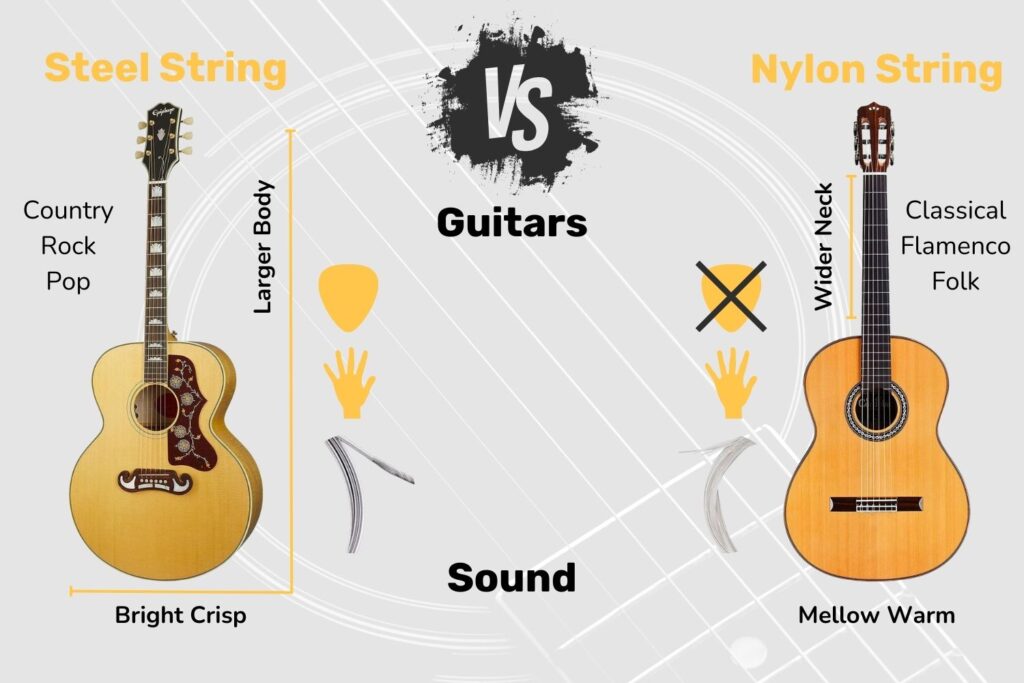
They are generally easier to press down, making them an excellent choice for beginners or those with tender fingers.
However, nylon strings are less durable compared to steel strings, and their tension tends to slacken over time, requiring frequent replacements.
On the other hand, steel strings are known to produce a bright, loud, and full sound which is most common in rock, blues, and country music.
They are more durable than nylon strings, responding better to rigorous strumming and sustaining a consistent tension over time.
However, they might pose a greater challenge to beginners as they require a stronger grip and can be hard on the fingers.
Another aspect to consider is the guitar’s built-in preamp and pickup as it relates to the type of strings.
Some pickups are designed specifically for nylon strings while others for steel.
Choosing a string type that’s not compatible with your guitar’s pickup can result in a lower output volume or a lackluster sound quality.
Additionally, the players’ style and genre of music also play a significant role in the choice of strings.
Accommodative styles such as classical, flamenco, or bossa nova might be best suited for nylon strings while steel strings would better accompany strumming or fingerpicking styles often associated with folk or bluegrass genres.
Adding to this, the playing comfort is another essential factor.
Some players find the softer, more mellow tone of nylon strings more appealing, as well as their softer touch on the fingers, while others might prefer the resistance and vibrant tone that steel strings offer.
Ultimately, the choice comes down to personal preferences and the player’s intended style of music.
It may also be a good idea to consult with a music professional or instructor to help guide this decision based on the player’s skills, taste, and future music goals.
Remember, there is no right or wrong choice here, whether nylon strings or steel strings—each has its unique features that cater to different kinds of musicians and genres.
Knowing what makes each one different is the key to making a well-informed decision that suits the individual’s musical style and comfort.
How to Tell if a Guitar Has Good Sound Quality?
As an aspiring musician or a seasoned guitarist, deciding upon a guitar with the best sound quality involves a firm understanding of your musical needs and listening preferences.
A crucial aspect of identifying a guitar that possesses top-notch sound quality lies in the realm of playability. A guitar that provides ease of playing should resonate with higher sound quality.
Always make note of the fretting hand comfort and measure the string action. Both these factors play a pivotal role in determining the overall sound quality.
The nut width is an important factor, which if too narrow or too wide for your hand, can impact the sound quality negatively.
Evaluating the guitar’s balance when you hold it in your hands will contribute to its playability and thereby the sound quality.
The guitar’s tonewoods are another pivotal factor contributing to its sound quality.
A guitar made of high-quality tonewood like spruce or cedar for the top and mahogany or rosewood for the back and sides will typically deliver excellent sound quality.
The craftsmanship and build quality of the guitar also play a significant role.
If you notice any gaps or uneven joins, it is likely to compromise the sound quality.
The sound quality of a guitar also lies heavily on the strings.
A good quality, well-maintained-string emits a sound that is sharp, clear, and ringing.
Frequent string changes to prevent corrosion and retaining its sharpness are ways to maintain the resonance and sound quality of the guitar.
Testing the intonation of the instrument by playing it up and down the fretboard, helps to ensure that the notes ring true no matter where you play them.
Finally, the electronic components of an acoustic-electric guitar play a vital role in defining its sound character.
A guitar with a high-quality pickup system and preamp, offering features like volume control, equalizer and tuner, will enable the player to customize the sound to their liking.
An easy way to assess the sound is by listening – a great sounding guitar should produce a balanced, even tone across all the strings and up and down the neck.
Lastly, it’s essential to remember that every guitarist has unique preferences. Therefore, if you enjoy the sound and feel of a particular acoustic-electric guitar, that’s probably the one for you.
What are the Best Brands in the Acoustic-Electric Guitar Industry?
When considering the best brands for acoustic-electric guitars, several notable names often spring to mind.
Martin & Co. enjoyed a long history of making quality guitars that date back to 1833.
The brand is known for its craftsmanship, quality of materials, and distinct tone.
Though Martin originally manufactured pure acoustic guitars, they have also ventured into the realm of acoustic-electric hybrids, blending their traditional sound with modern pick-up systems.
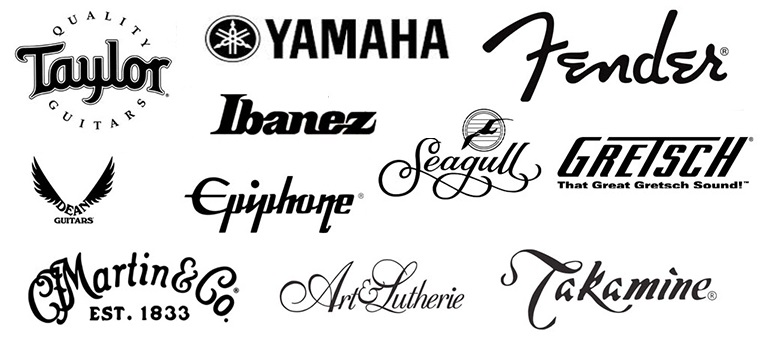
Another prominent brand is Taylor Guitars.
Their appeal lies in their consistently high-quality acoustic-electric guitars, their innovation in guitar design, and responsiveness to musicians’ changing needs.
Gibson, though primarily recognized for its electric guitars, also manufactures some of the most respected acoustic-electric guitars in the market.
Their J-200 acoustic-electric model is well-regarded for its warm and full-bodied tonality.
On the other hand, Fender is also a venerable brand in the guitar production industry.
While most commonly associated with solid-body electric guitars like the Stratocaster and Telecaster, Fender has been producing acoustic-electric guitars like the Acoustasonic series to great acclaim.
A yet another famous brand is Ibanez, originated from Japan.
Known for their high-quality manufacturing standards and wide range of styles, they present a great option for various skill levels and musical genres.
It’s important to remember that the best brand can also be subjective.
It depends greatly on an individual’s personal preferences, including the guitar’s feel, tone, and aesthetic.
While these brands cover a wide price range, another crucial factor in determining the best brand is the value for money.
Beginner guitarists may find brands like Yamaha and Epiphone offering very reliable guitars at more affordable prices.
Although these guitars may not have the prestige of high-end brands, they offer a good balance of quality and affordability for those looking to jump into the world of acoustic-electric guitars.
When looking for the best brand of acoustic-electric guitar, you should also consider warranty and customer service.
Matters relating to repair, replacement parts, or technical support often come up during a guitar’s lifetime, and brands offering comprehensive customer service hold a certain edge.
Above all, the best brand is usually the one that feels, sounds, and looks right to the individual player.
Whether it’s the hand-finished detail of a Martin, the innovation of a Taylor, the heritage of a Gibson, the versatility of a Fender, the value of a Yamaha, or the rock ‘n’ roll flair of an Epiphone – there’s an acoustic-electric guitar out there for everyone.
Acoustic Guitars vs. Acoustic-Electric Guitars?
This age-old query often comes up in the minds of novices as well as seasoned guitar enthusiasts – the choice between acoustic guitars and acoustic-electric guitars.
Let’s first get a clear understanding of these two.
An acoustic guitar is designed so that its sound is naturally amplified with the help of its hollow body structure, also known as a sound box.
On the other hand, an acoustic-electric guitar is essentially an acoustic guitar equipped with electronic components that allow it to be plugged into an amplifier or sound system.
The key question here is, which one to pick?
The answer to this dilemma primarily depends on your individual requirements and the kind of music you are more inclined towards.
If you’re a solo player who enjoys playing at home, or in intimate settings, an acoustic guitar will work perfectly well for you.
The natural sound it produces doesn’t need any external amplification making it self-sufficient and convenient to use.
On the other hand, if you’re planning on performing in large venues or looking to experiment with sound effects, an acoustic-electric guitar would be a more suitable choice.
With its built-in electronic components, you can connect it to an amplifier or a PA system ensuring that your performance reaches out to all listeners.
Additionally, most acoustic-electric guitars come with onboard controls for volume and tone, offering you the provision to control your sound directly from your instrument.
When it comes to recording, acoustic-electric guitars are more versatile.
You can either play unplugged for a natural sound or plug into a sound system for a more amplified, shaped sound.
It crucially takes away the hassle of having to mic up an acoustic guitar for recording, making it a more convenient option.
A point to remember, both these types of guitars have a distinctly different tone.
The natural resonance of an acoustic guitar’s body and the sound that emanates from within its hollow structure is distinctly different from the amplified tone of an acoustic-electric guitar.
Hence, your choice should also bank upon the tonal preferences you hold.
In terms of cost, acoustic-electric guitars are generally more expensive than their purely acoustic counterparts due to the added electronics.
So, your budget can also guide your decision towards one or the other.
Finally, because guitars are also an investment, consider their resale value.
Acoustic-electric guitars often fetch a higher price on the resale market because of the added features and flexibility they offer.
At the end, remember there’s no right or wrong when it comes to choosing between these two types of guitars.
It all comes down to your play style, music preference, budget and particularly, the sound that resonates with you the most.
What are the Different Types of Acoustic-Electric Guitars?
It’s important to note that there are several different types of acoustic-electric guitars.
Each type provides a unique sound and playing experience due to their construction and design elements.
An example of one such type is the dreadnought acoustic-electric guitar.

Named after a type of British warship, the dreadnought guitar is a favorite choice amongst many guitarists due to its body shape which provides a robust and rich sound.
Another common type is the jumbo acoustic-electric guitar.
As implied by their name, these guitars have a bigger body size producing a loud volume and full tone, making them perfect for stage performances.
The parlor acoustic-electric guitar is another example.
Known for their smaller and narrow bodies, these guitars produce a brighter and less booming sound ideal for fingerpicking styles, intimate settings, and recording sessions.
On the other hand, concert acoustic-electric guitars are another popular choice.
These guitars have a mid-range body size creating a balanced sound suitable for a mix of strumming and fingerpicking styles.
One other is the travel or mini acoustic-electric guitar.
As the name suggests, these are smaller versions of full-sized guitars and are great for traveling musicians, beginners, and children.
An additional type is the cutaway acoustic-electric guitar.
These guitars have a distinctive design where a portion of the lower bout is cut away to allow easier access to higher frets – a feature highly useful for solo performers and lead guitarists.
Each of these types of guitars can be further divided into the classic and flamenco style acoustic-electric guitars.
The first one features a warm and rich tone while the latter caters to a brighter and louder sound.
Remember, the choice of guitar type greatly depends on the music style that you wish to play, your personal preference, and your comfort level.
So, it would be advisable to try out different types of acoustic-electric guitars before making a decision.
In any case, having a thorough understanding of the different types of acoustic-electric guitars will undoubtedly be helpful in expanding your musical repertoire and proficiency.
How Important is the Size of an Acoustic-Electric Guitar?
When it comes to discussing acoustic-electric guitars, it is impossible to overlook the significance of size.
The size of the guitar is a determining factor in many aspects, from tones and sounds to physical convenience.
Size plays a crucial role in producing the rich, dynamic tones that acoustic-electric guitars are famous for.
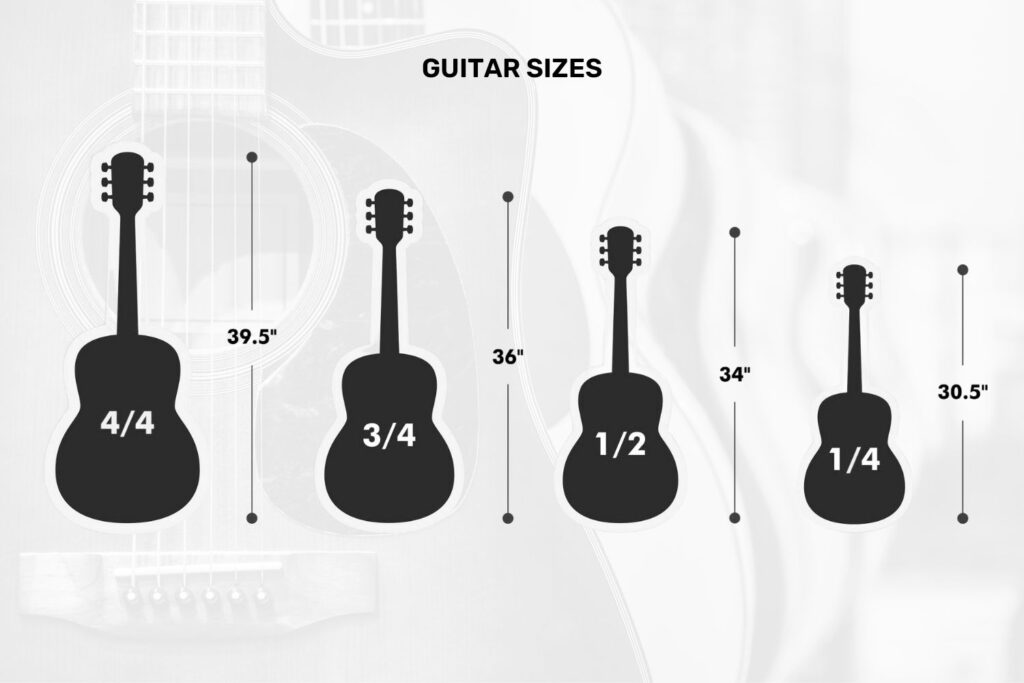
Large guitars generally have more space for sound to resonate, which often results in a fuller and richer tone.
For example, guitars built with a larger body, such as a jumbo or dreadnought, are known to yield a boisterous, full-bodied sound that is suitable for strumming.
This is an essential factor to consider for songwriters or performers who like to capture the audience’s attention with powerful, commanding notes.
On the contrary, smaller-sized guitars, like parlour or orchestra models, tend to produce more balanced and focused tones.
This makes them a good choice for performers who are into fingerstyle playing as they give more prominence to subtle nuances in your playing.
Apart from generating distinct sounds, the size of the acoustic-electric guitar also influences the player’s comfort level.
Comfort pertains, not just to how the guitar feels when you hold it, but also how convenient it is to play.
Smaller guitars are a favourite amongst beginners or young players due to their manageable size.
They are easier to hold and play and can aid in honing your guitar skills without straining your body.
Performers with a smaller stature may find larger-sized guitars cumbersome and challenging to handle.
On the other hand, tall and broad-shouldered players might find large guitars comfortable and small ones somewhat restricting.
The impact of guitar size extends to its portability and transportation. If you’re someone who frequently travels for gigs, you might prefer the convenience of carrying a small to medium-sized guitar as opposed to a large one.
Moreover, the guitar’s size impacts its volume and projection. Larger guitars have better sound projection due to their large body, which comes handy during unamplified performances.
However, with acoustic-electric guitars, you have the convenience of plugging into an amplifier and adjusting the volume as per your needs.
It’s crucial to strike a balance when deciding on the size of your acoustic-electric guitar. Consider the kind of music you want to play, your physical comfort, and the guitar’s practicality before making a purchase.
Only then, you will be able to harness the true potential of your guitar and revel in its rich, dynamic sound.
It’s also advisable to try before you buy. Spending some time in the local music store, strumming different guitar sizes might give you a better idea of what suits you.
Remember, the right guitar size for you depends on you- your body, your hands, your style.
Let your comfort be the ultimate judge. No brand, review, or professional advice can tell you more about the right guitar size for you than your personal comfort and convenience.
Therefore, don’t take the size of an acoustic-electric guitar for granted. It not only shapes your sound but can also either limit or enrich your overall playing experience.
What Role does the Shape Play in an Acoustic-Electric Guitar’s Sound?
The physical shape of an acoustic-electric guitar plays a role in its sound – an aspect that often goes unnoticed.
The variation in their shapes isn’t just for aesthetic reasons but significantly contributes to the tonality of the guitar.
The body style influences both the sound and the comfortability of playing because the design of the body could greatly determine the balance, reach and ease of access to upper frets.
There is a wide diversity of guitar body styles that contribute differently to the sound.
One of the most common choices, the dreadnought body shape, is well-loved for its balanced frequency response and depth of tone.
Meanwhile, the smaller body types, like the parlor or orchestra-style guitars, are known for their bright, focused tones, suitable for fingerpicking.
On the other hand, the jumbo style guitar, being larger, can offer richer bass and greater overall volume.
It’s crucial to understand that the guitar’s upper bout, waist, and lower bout, all contribute to the guitar’s tonal characteristics.
The bounding materials and shape of the guitar’s sound hole, significantly impact the sound as well.
The sound hole’s purpose isn’t just to allow sound to project outward, but also to direct the airflow in the guitar’s body, which influences the resonance and overall sound quality.
Furthermore, the guitar’s shape can amplify certain frequencies and deaden others.
So, the choice of the guitar body style and shape should align with the player’s playing style and the kind of music they want to produce.
However, there isn’t any ‘one size fits all’. Each player gravitates towards a particular guitar shape due to its tonal properties and how comfortable they feel while playing it.
While the shape of your acoustic-electric guitar does play a key role in the tonal output of your guitar, other variables such as the type of wood, the gauge of your strings, and your playing technique also contribute largely to your overall sound.
Therefore, to get the best of both worlds, individual preferences should be taken into account along with the shape of the acoustic-electric guitar.
It’s crucial for every guitar owner and potential buyers to understand the importance of the role of the shape in the sound production of an acoustic-electric guitar.
This knowledge might be the elixir to making you a better guitar player, affecting your sound and even the way you write music.
Finally, keep in mind that the art of getting the best sound from your acoustic-electric guitar involves the blend of various factors, with the shape being an integral part of it.
The Bottom Line
Through our exploration of the top acoustic-electric guitars, it’s clear that there is an array of superb options on the market.
From cutting-edge builds, timeless classics, to audience-winning designs, each guitar offers its unique flair and sound for music enthusiasts.
Every guitar has its charm, each clearly excelling in their own right, with incredible sound quality and exceptional craftsmanship.
Your choice ultimately depends on personal preference, each instrument resounds with its own unique voice and suits different kinds of music genres.
Remember that a great guitar not just enhances the quality of your music, but also makes your journey as a musician more enjoyable and fulfilling.

